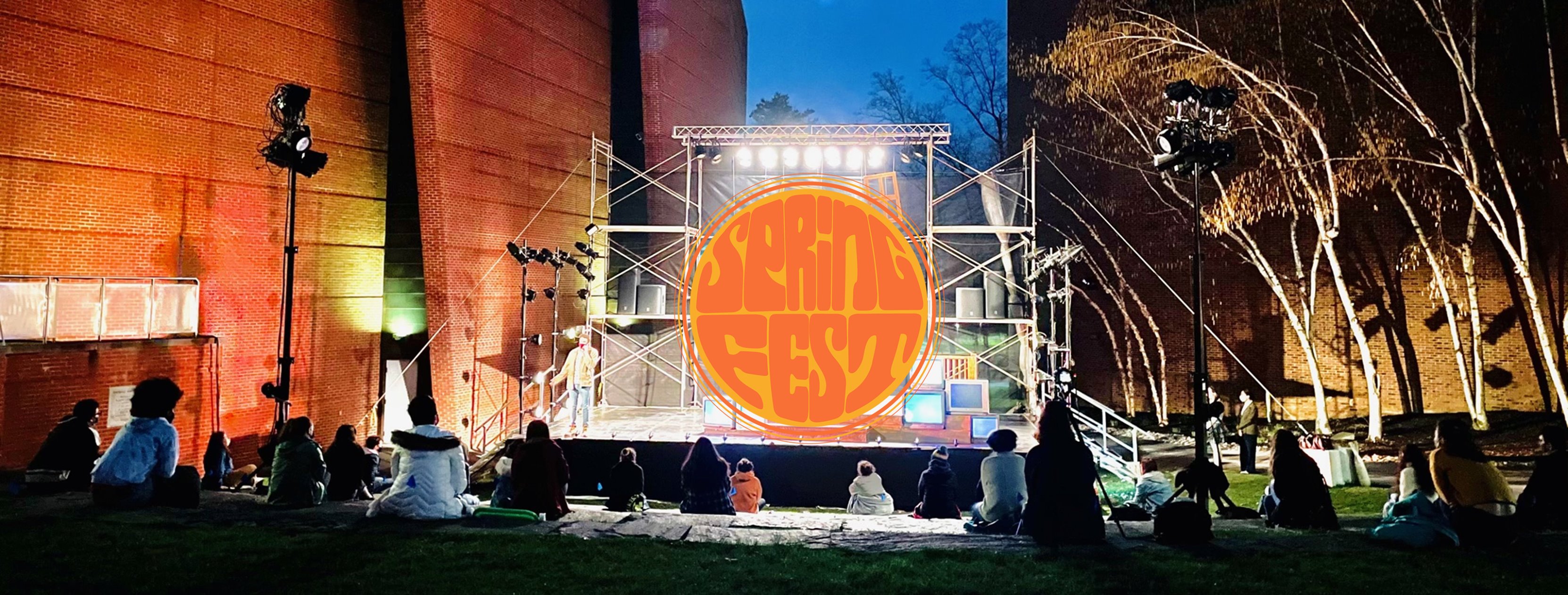Co-Edited by Eliza Kuperschmid ‘21 and Gemma Siegler ‘22
The first weekend of SpringFest was a huge success! It was so exciting to see live and in-person work by students happening around campus for the first time in a while. The energy surrounding the festival itself was full of bright enthusiasm; everyone in each audience just seemed to be happy to see live theater again. This excitement was, and continues to be, contagious.
With fifteen different performances happening over the next three weeks, STLN thought that the best mode of reporting would be “Weekend Wrap-Ups,” one article per weekend containing everything you need to know about what happened on the SpringFest stages. Hopefully the joy of the SpringFest audience members can be felt through our staff writers’ brief summaries of each weekend one performance below!
___
Kaleidoscope
Covered by Eliza Kuperschmid ‘21
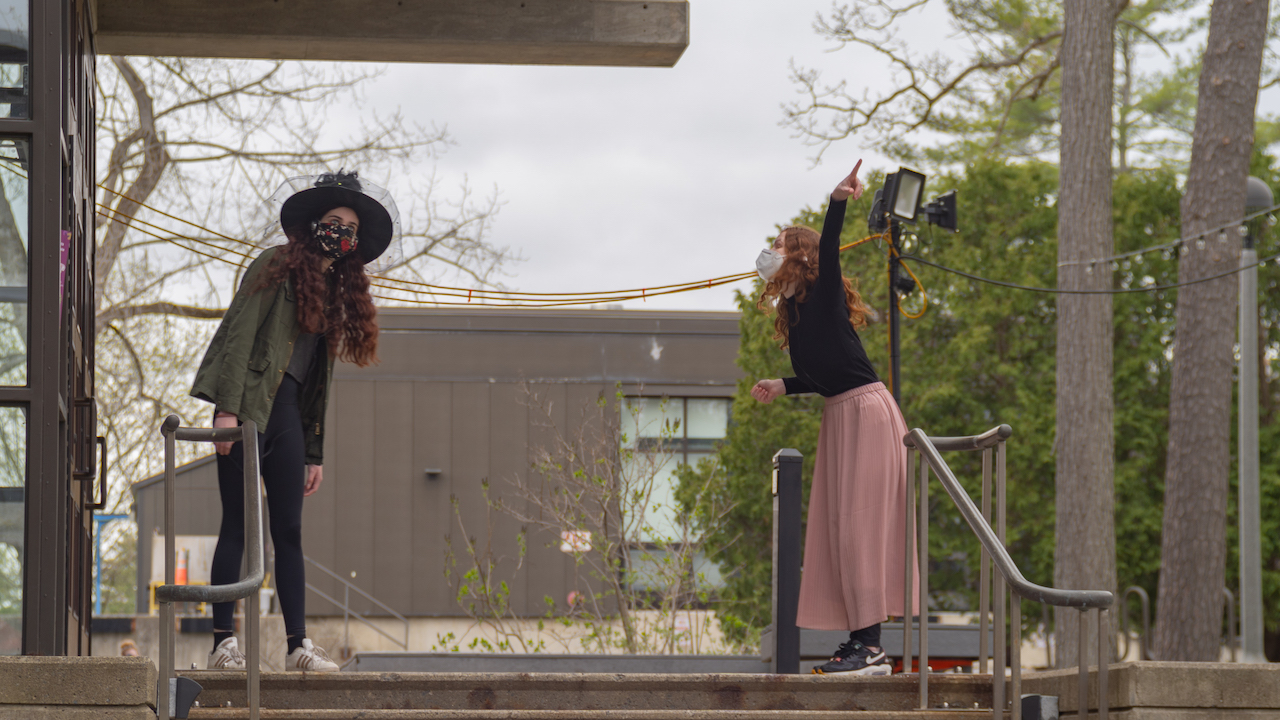
Photo by Coltrane Cho ’24
The first show of the weekend was Kaleidoscope, conceptualized by lead artist Micah Pflaum ‘23 and directed by Sully Sullivan ‘22. It was probably one of the most delightful pieces of theater I’ve seen in a while. When audience members arrived at the performance space, which was the green space and pathways in between the Tisch Learning Center and Palamountain Hall, they were instructed to see stage manager Shelby Fairchild ‘21 for a special viewing device. Audience members each received a pair of wired headphones and a hand-held audio device, all expertly sanitized within COVID parameters. The audience members were then led to stand in individual chalk-marked circles as the performance unfolded about 50 feet away from them.
I put on my headphones and listened as the story played out. A princess (played by Kate Hoag ‘23) and a wizard (played by Erin Einzig ‘23) emerged from the Palamountain pathway walking side by side. The two gushed over the fact that they were on a first date and were excited to get to know more about one another. Suddenly, the princess’s ex appeared (played by Anna Krechevsky ‘22) and after a duel for the princess’s hand, a magical spell, and a beastly transformation, the three players decided that they should just compromise and try their hand at a polyamorous relationship instead.
Throughout the performance, I chuckled and smiled and I noticed that a few other audience members did the same. However, some audience members were silent when I laughed or laughed during a time during which nothing necessarily funny was happening. I wondered why that could be.
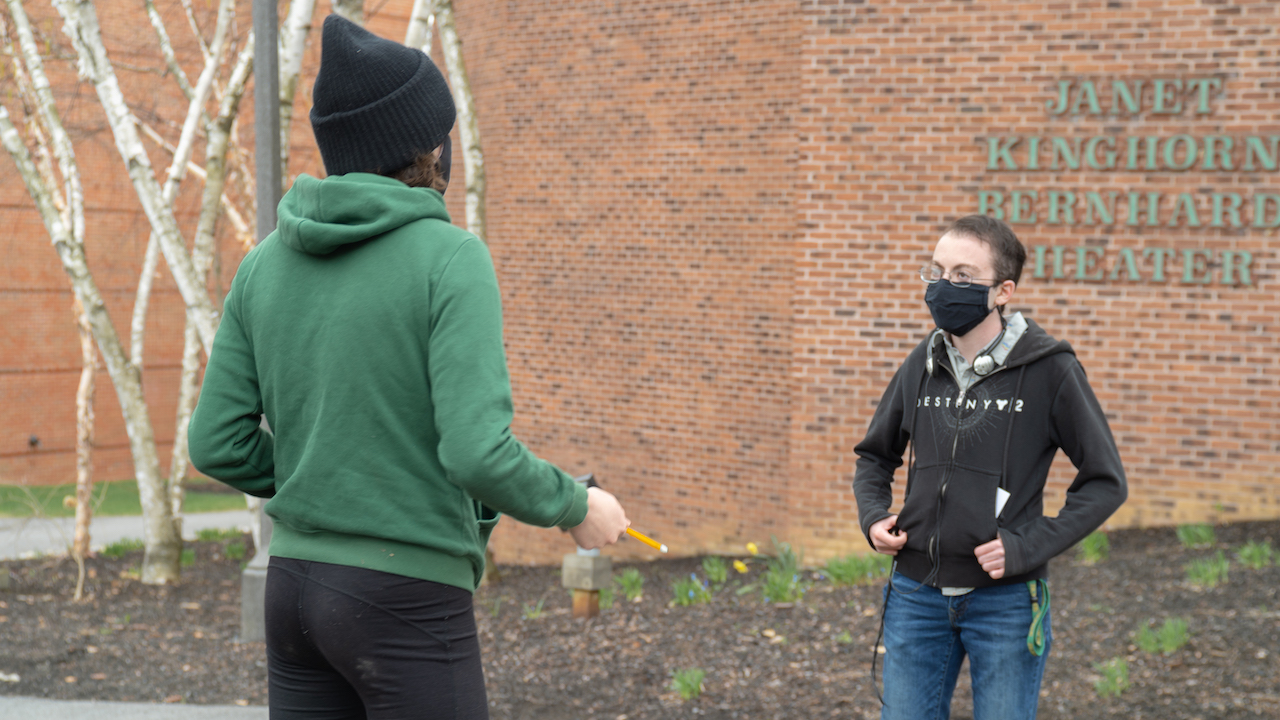
Photo by Coltrane Cho ’24
After the performance ended, Micah, Sully, Shelby, and the cast asked if the audience could stick around for a brief talk-back. Micah asked the audience some classic talk-back questions like “what did you notice?” and “what was the play about?” to which some audience members called out general words like “magic” and “princess.” Everyone seemed to be on the same page: the story was fairly straightforward and we all knew what the play was about.
Until Sully asked one audience member in particular to give a play-by-play summary of the story to the rest of the group. The audience member started explaining the plot, citing friends summoning a demon and demonic possession as some of the highlights.
Everyone suddenly looked around in confusion and whispers of wait, that was not the story I heard! spread throughout the crowd. When the realization hit, the audience once again cheered and applauded Micah and the Kaleidoscope team. It turned out that there were different audios in the headphones; the story that you heard depended on which audio you had received at the top of the performance. The ensemble performed perfectly in sync with each audio, each story making sense with the movement because of how cleverly the piece was devised.
Kaleidoscope was a thrilling experiment in an audience’s critical role in a live performance. In any theatrical piece, each person enters the space with their own biases and preconceptions. In Kaleidoscope, the audience’s experience was directly influenced by what they were hearing, not seeing. This was an important lesson in audience awareness and, as I said, a delight to be a part of. I look forward to seeing how this innovative technique in theater-making will evolve in the future.
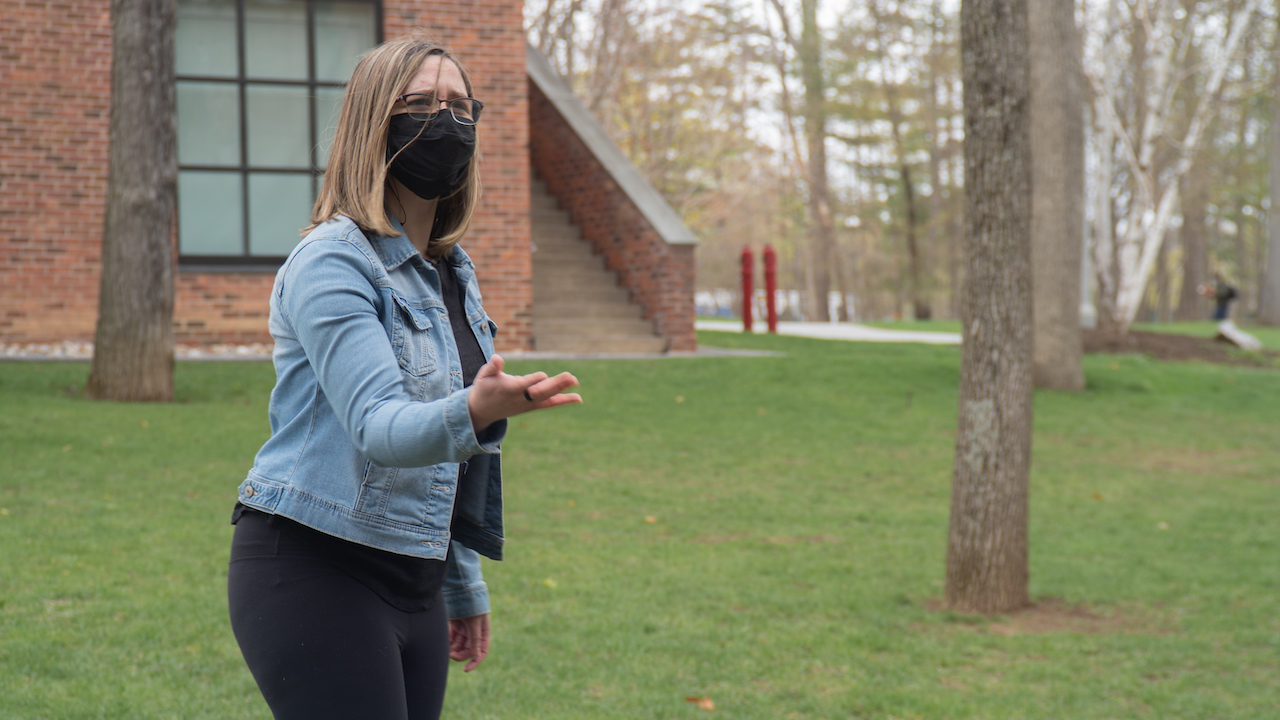
Photo by Coltrane Cho ’24
LEAD ARTIST/PLAYWRIGHT: Micah Pflaum ‘23
DIRECTOR: Sully Sullivan ‘22
STAGE MANAGER: Shelby Fairchild ‘21
SOUND DESIGN: Shelby Fairchild ‘21
CAST: Erin Einzig ‘23, Kate Hoag ‘23, Anna Krechevsky ‘22
___
Young
Covered by Madeline Munding ‘22
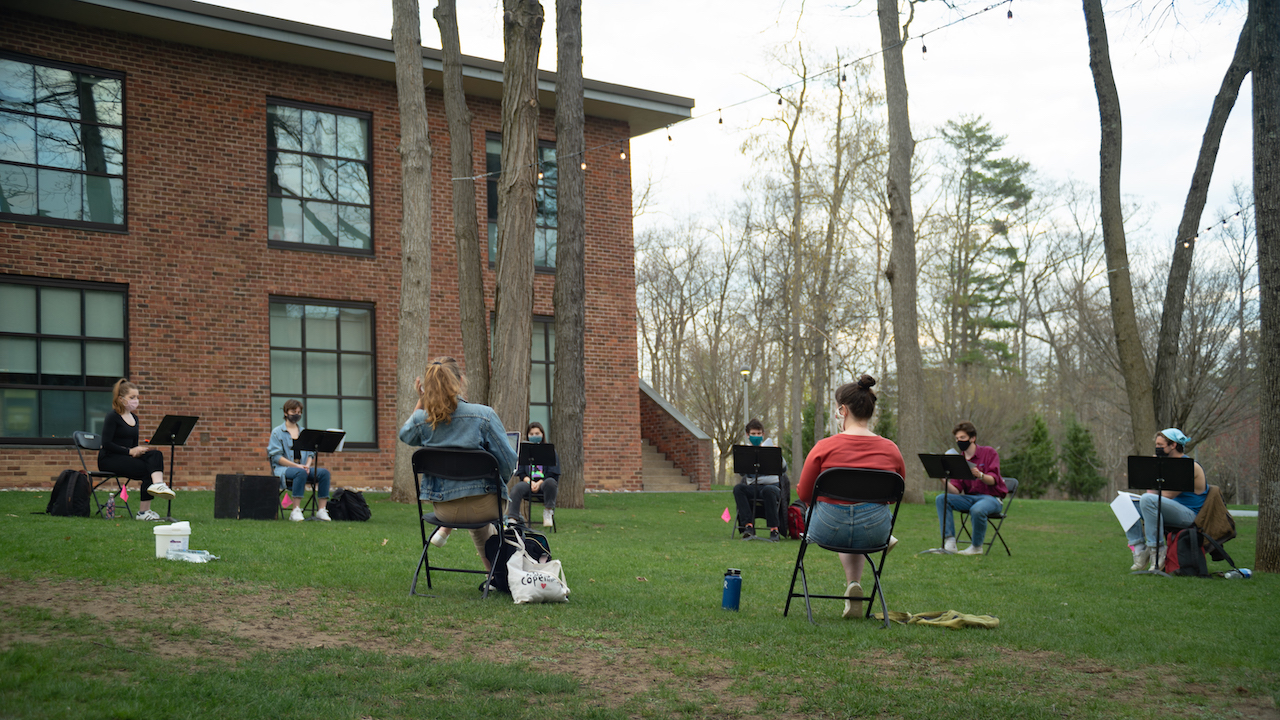
Photo by Coltrane Cho ’24
The next show featured in the lineup was Young, written by Kat Collin ’21 and directed by Amanda Hinge ’21. Young follows the story of 17-year old Lauren (Tait Brencher ’23) as she navigates substance abuse, predatory and manipulative relationships, mental health, and body image issues. Lauren struggles to find her way in this chaotic environment that continuously crushes her true self-identity. With the help of some magical forest creatures, she is given tools to conquer her inner demons and learns to find and accept herself again before it becomes too late and she spirals completely out of control.

Photo by Coltrane Cho ’24
Young also starred Brendan Higham ’21, Tyler Gundrum ’21, Liliana Mastroianni ’22, and Jordan Gonzales ’24, all of whom played multiple roles in the reading. With the COVID levels on campus temporarily halting all in-person performances, Young had two performances on Zoom on April 17th and 18th. Despite the virtual barriers, Bridget Schwartz ’21 read extremely vivid, detailed stage directions that created fantastic design concepts in audience members’ minds.
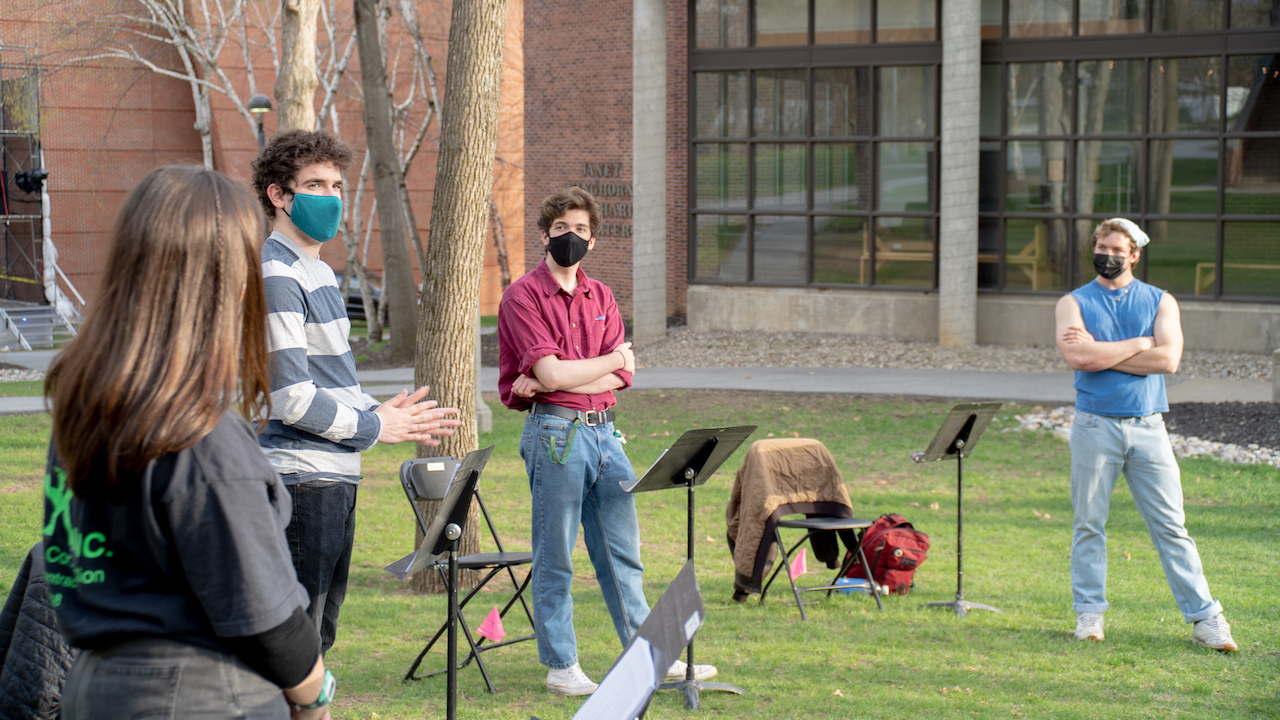
Photo by Coltrane Cho ’24
This was perfectly showcased near the end of the play when Lauren confronts her toxic inner self, Jess (Jordan Gonzales ’24). Using the tools of strength that she develops over the course of the play, Lauren drops golden marbles that make Jess trip and stumble as they charge her. Lauren then proceeds to shoot Jess with golden arrows from a golden bow, pinning them to a wall. Defeated, Jess combusts into a cloud of butterflies.
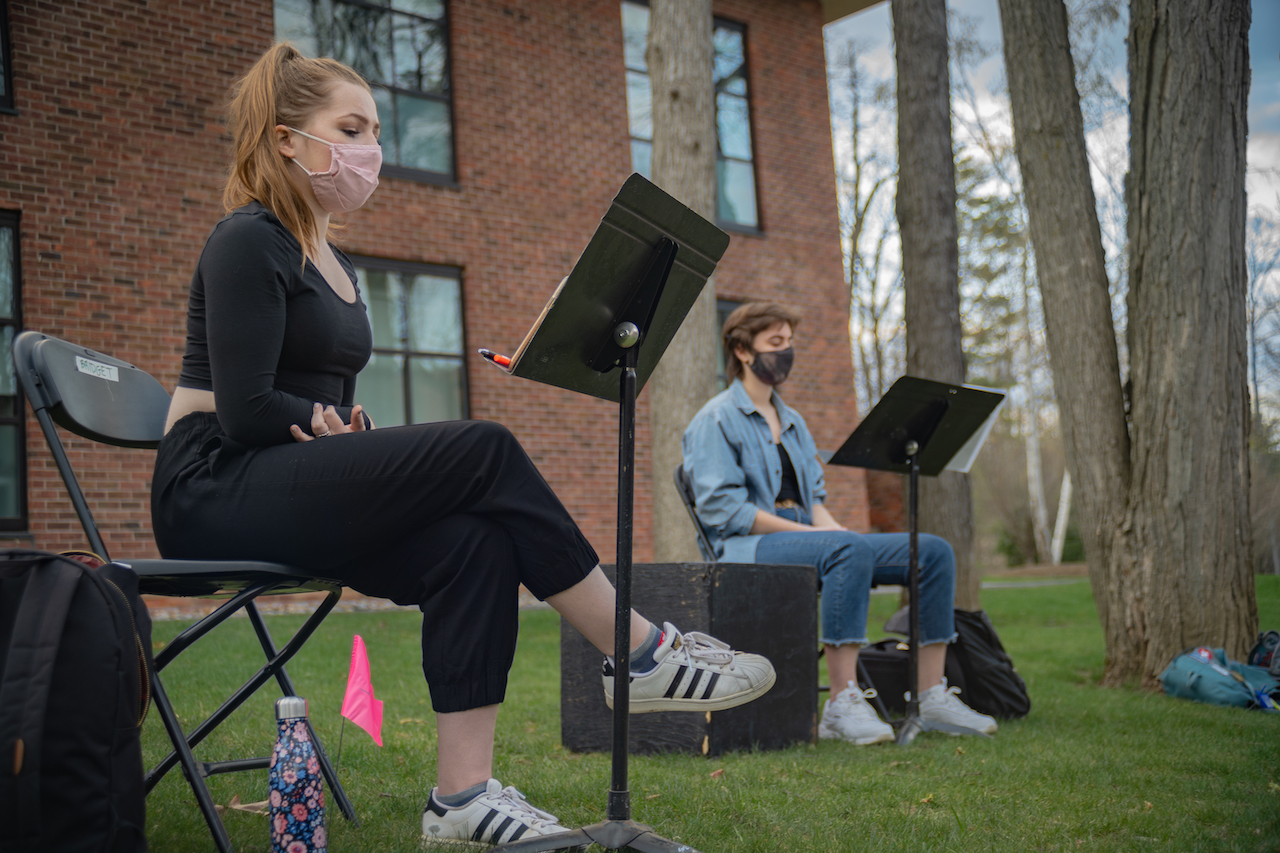
Photo by Coltrane Cho ’24
As previously stated, Young centers on issues such as substance abuse, predatory relationships, manipulative relationships, and body shaming. The play asks of us why adults, who are supposed to protect and nurture children, end up harming them instead. There is representation of the effects of body shaming at home and what steps an individual must take to regain control of their identity. Collin’s play centers on a pivotal, developmental time for adolescents that can transport viewers back into their own youth for not only the play’s duration but even after, encouraging viewers to examine their own story through a more critical lens.
Young has its own website that provides more details about the show and cast, pictures, content warnings with helpful resources, and a playlist for the show. Check it out here: https://awhpanda.wixsite.com/young.
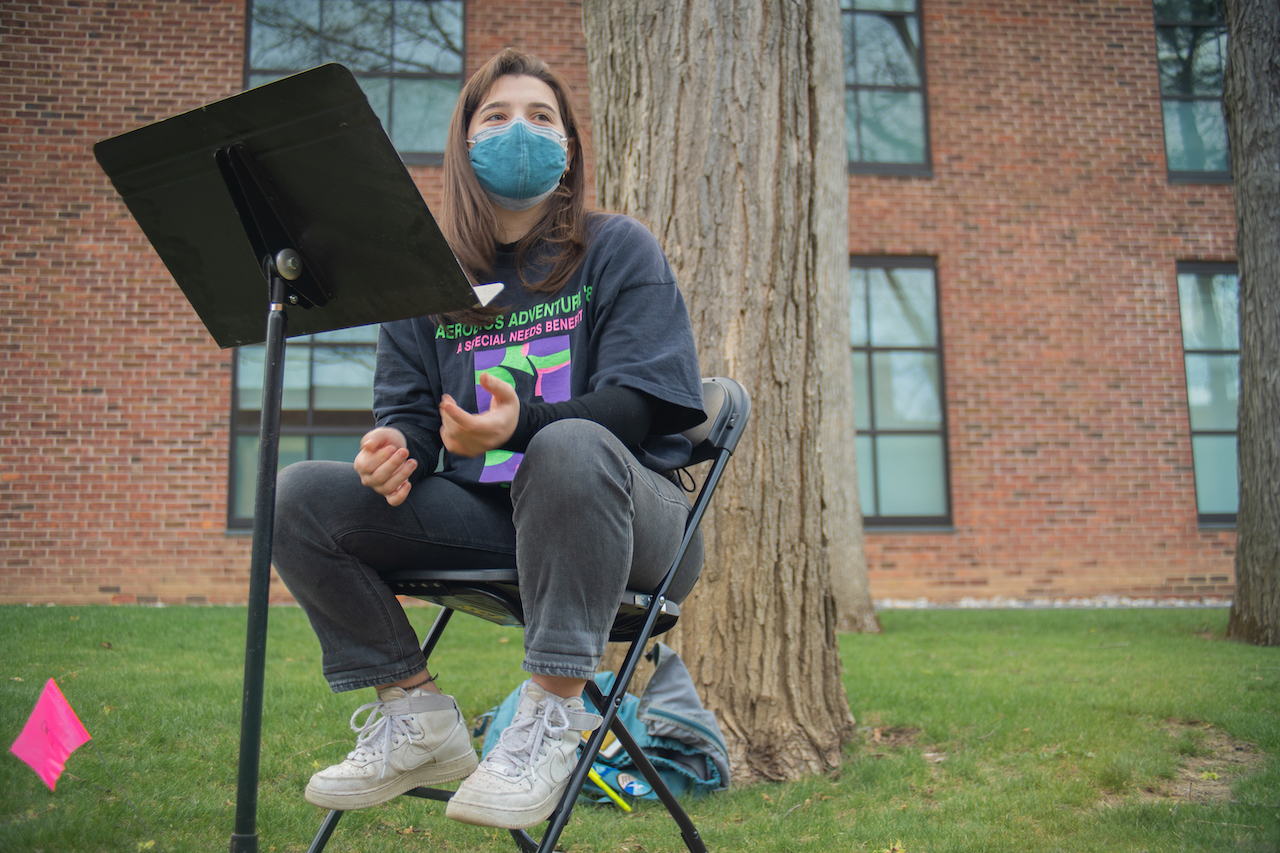
Photo by Coltrane Cho ’24
LEAD ARTIST/PLAYWRIGHT: Kat Collin ’21
DIRECTOR: Amanda Hinge ‘21
CAST: Tait Brencher ‘23, Jordan Gonzales ’24, Tyler Gundrum ’21, Brendan Higham ’21, Liliana Mastroianni ’22, Bridget Schwartz ’21
___
Bamboo Box
Covered by Cas Clifford ‘21
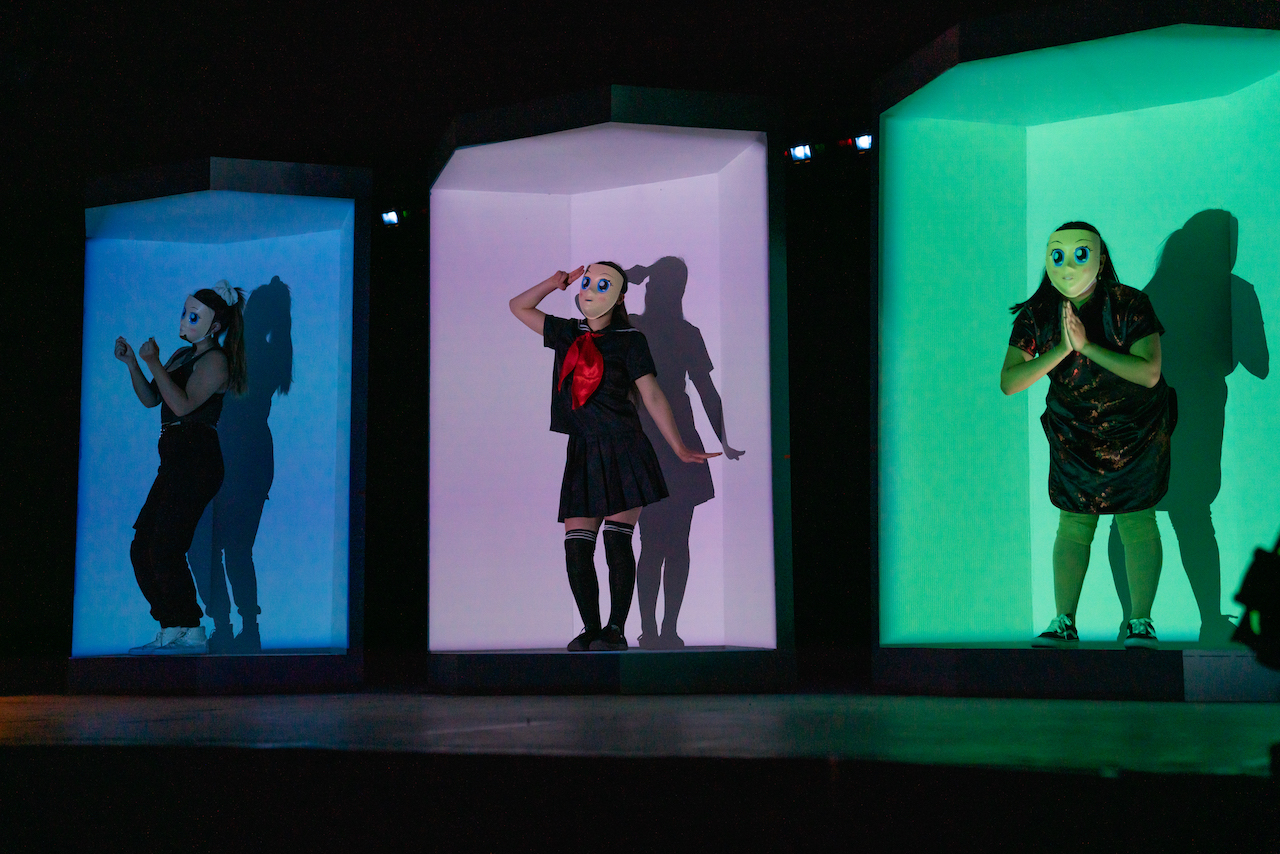
Photo by Coltrane Cho ’24
SpringFest is occurring at a difficult time for the AAPI community. As COVID triggers a rise in anti-Asian rhetoric, Bamboo Box, conceptualized by Wynn Lee ‘21, serves as a potent and unapologetically Asian voice in a predominantly white institution.
This project was created as a direct result of the hypocrisy that the lead artist, Wynn Lee’ 21, observed during the covid pandemic, and particularly came from their frustration with the ways in which the blame of this pandemic was pinned on not just one country but an entire ethnicity. “While people are beating and killing us, the same people would appreciate our media,” Lee says when asked about the motivation for the project. “In a way, I wanted the audience to become hypocrites as they watched the show.”
As you enter the space of Bamboo Box, you are greeted with three colorful boxes. These are revealed to be containers for a new line of “models.” The models are presented to us by an announcer (Carter Jones ‘22): “K-pop Idol” (Émilie-Anne Choi ‘22), “China Doll” (Ayesha Robyn F. Domingo ‘22), and “Weeb Waifu” (Jessie March ‘21). Each of the models are wearing disturbing anime face masks. They each strike a pose and the performance begins.
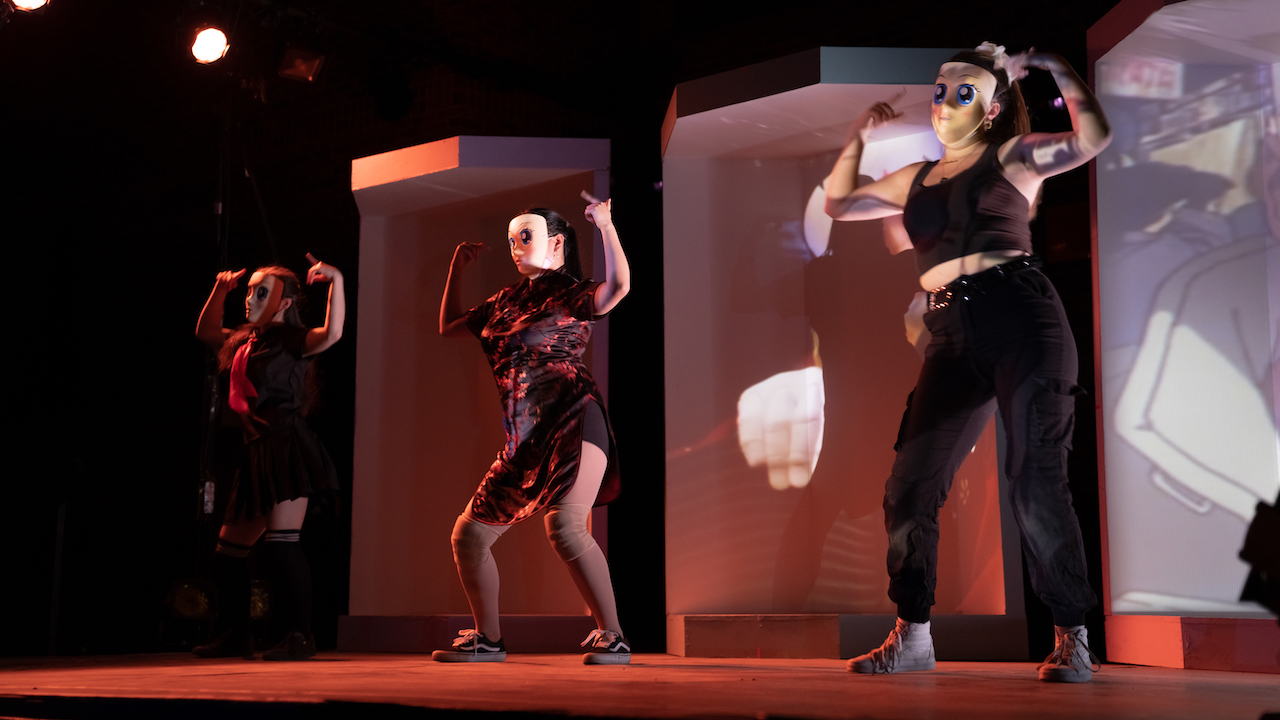
Photo by Coltrane Cho ’24
The audience is propelled into a colorful world of anime, K-pop, C-pop, and Chinese fashion Tik Toks. The models begin to dance along to the music. The music and the visuals are constantly changing, and the dance (choreographed by Annie Cox ‘21 with assistance from Lucrezia Zichichi ‘24 and directed by Gemma Siegler ‘22) is captivating. From here though, things get much darker. The dance and video become more sexual, including projections of pornography. Then, the piece breaks. The music decomposes as the audience views a rapid onslaught of bigoted stereotypes and footage of real-life hate crimes. The experience is overwhelming, the dancers are thrown off their balance. It becomes so much that the presentation crashes and must reboot. The audience is left in silence, with nothing more than the phrase “for your convenience” scrolling across the models.
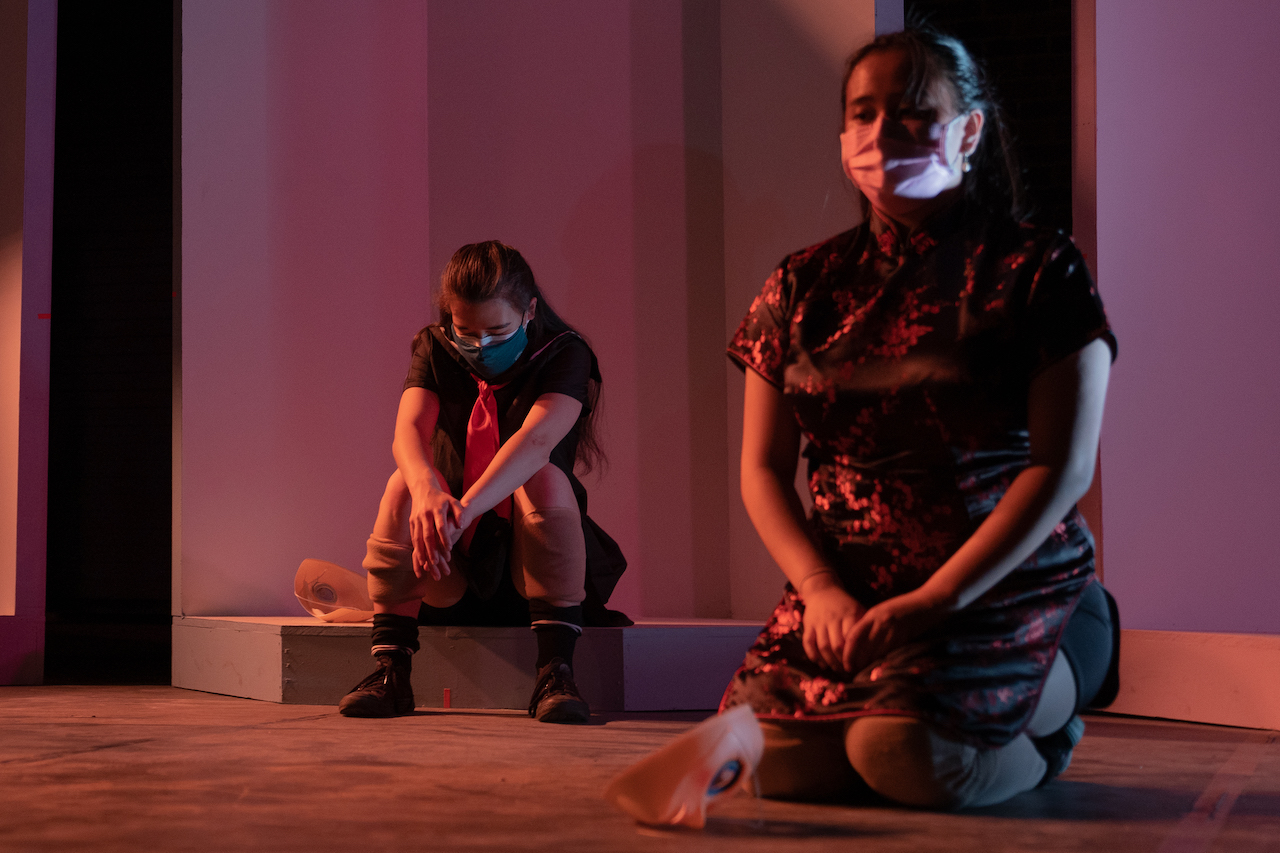
Photo by Coltrane Cho ’24
Bamboo Box is a potent satire of the traumatic experiences of AAPI living in America. The myth of the model minority, which is consistently used to downplay the pain and oppression experienced by AAPI, is turned into a presentation of real-life “Models for Your Convenience.” They dance along to popular clips from anime, K-pop, and C-pop, which are commonly commodified by non-AAPI as a means of fetishizing Asian cultures. As the experience grows more sexual, the way in which Asian women are sexualized is highlighted. The colorful veneer falls away and the hate that lies underneath is laid bare on stage so severely that it breaks the entire system.
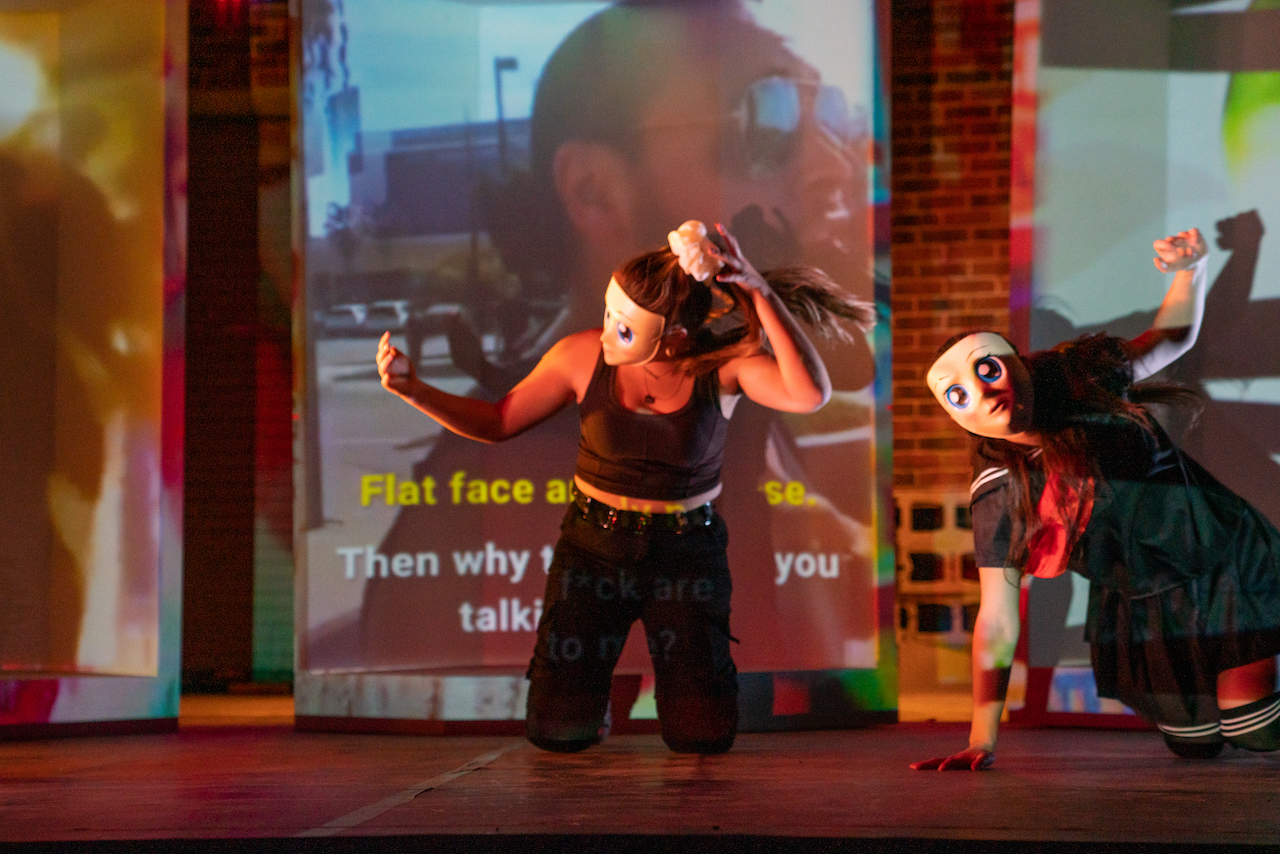
Photo by Coltrane Cho ’24
The subject matter of Bamboo Box is heavy, but the creative team pulls it off with grace. The piece has a sardonic sense of humor which gives way to a painfully clear presentation of trauma. The piece manages to present a look at the many different ways in which anti-AAPI rhetoric manifests, and manages to do so in ten minutes with almost no dialogue.
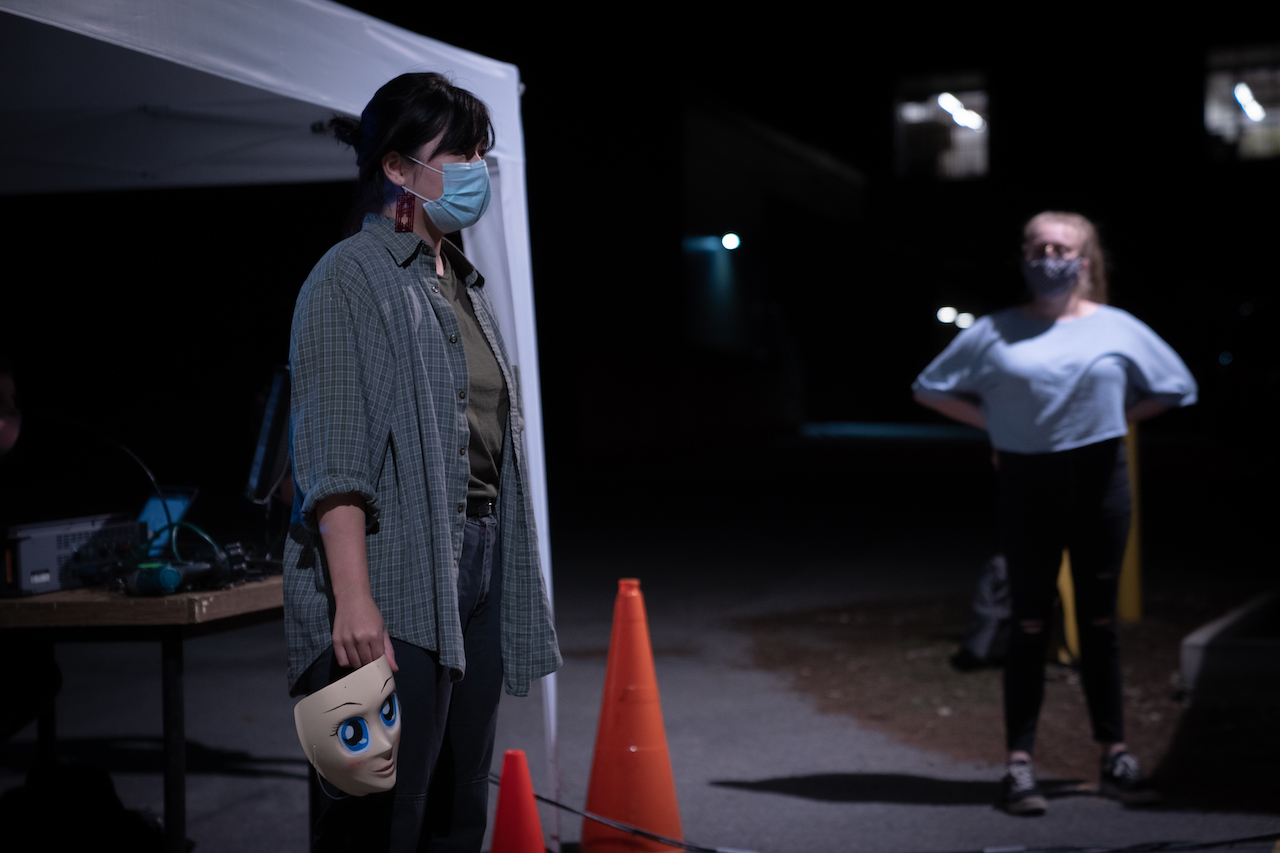
Photo by Coltrane Cho ’24
The design elements of the show were expertly woven together to create a solid viewing experience. The titular boxes, designed and built by Wynn, served not only as a storytelling device but also as a projection surface. The video and sound (designed by JKB alum August Sylvester ‘20 with assistance from Braedon Quinlan ‘24) created a sensory overload that served to score the dance and push the narrative forward. Lighting by Libby Hinshaw ‘23 was colorful and helped to usher us into the world of the play and costumes (designed by Arielle Lam ‘24) created perfect encapsulations of Asian cultural stereotypes. The Lead Artist’s background in design is highlighted in the way in which design is deeply ingrained into the cumulative experience of the story. Every element of Bamboo Box is solid and creates one dynamic experience that serves as a necessary outlet during a painful time.
Support your AAPI peers. https://www.stopaapihate.org https://www.stopasianhate.info
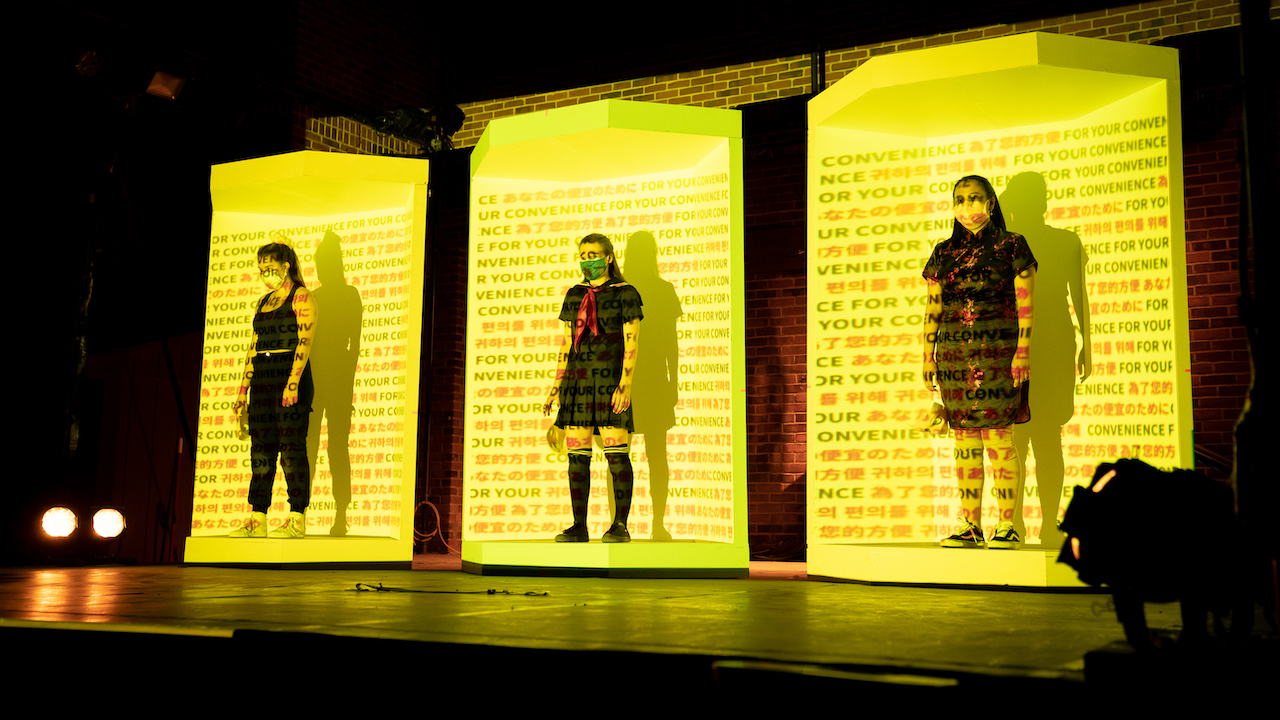
Photo by Coltrane Cho ’24
LEAD ARTIST: Wynn Lee ’21
DIRECTOR: Gemma Siegler ’22
STAGE MANAGER: Georgianna Zanotto ’23
SCENIC DESIGN/PROPS MASTER: Wynn Lee ’21
LIGHTING DESIGN: Libby Hinshaw ’23
SOUND DESIGN/PROJECTION DESIGN: August Sylvester ’20
ASST. SOUND DESIGN/ASST. PROJECTION DESIGN: Braedon Quinlan ’24
COSTUME DESIGN: Arielle Lam ’24
CHOREOGRAPHER: Annie Cox ’21
ASST. CHOREOGRAPHER: Lucrezia Zichichi ’24
CAST: Émilie-Anne Choi ’22, Ayesha Robyn F. Domingo ‘22, Jessie March ’21
___
Borrowed Letters
Covered by Maggie McGuire ‘24
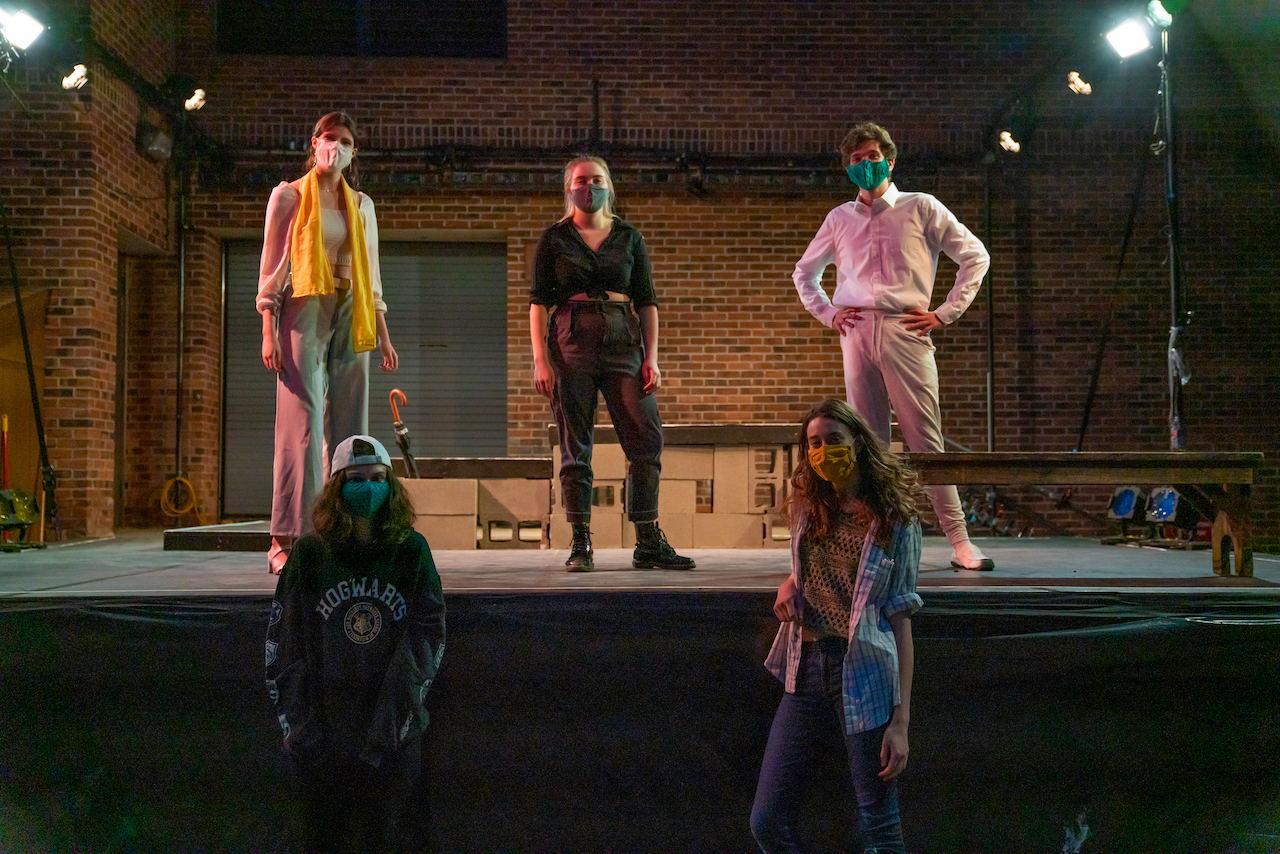
Photo by Wynn Lee ’21
Borrowed Letters is a one-act, episodic take on Cyrano de Bergerac, written in 1897 by Edmond Rostand. As a part of the opening weekend of SpringFest, this production, directed by Amelia Schuster ’21, took place on April 17 and 18th outside the JKB on the loading dock stage. The play has a strong Romeo and Juliet feel to it, as it follows three star-crossed lovers in their struggle to confess their true feelings for one another. However, this version of the classic French tragedy has a few twists- it is told out of order to show the perspectives of all three characters. Also, whereas Cyrano would be traditionally played by a man, Cyrano in this production is a woman.
The plot of Borrowed Letters begins in the middle of Cyrano de Bergerac, when Roxanne, portrayed by Gigi Brown ’24, finds herself in the middle of a romantic crisis. She is in love with Christian, portrayed by Jordan Gonzales ’24, who has been sending her the most eloquent of love letters, despite the fact that he is not eloquent himself. Cyrano, portrayed by Erin Arnold ’23, confesses to Roxanne that she intends to marry Christian in secret. When both Cyrano and Christian are sent to war, Christian keeps writing every day twice a day, up until his death on the battlefield. This, however, is not the end as thanks to a series of flashbacks from Cyrano’s perspective, the audience learns that she had been sending the letters all along as she loves Roxanne, but fears that love would not be reciprocated.
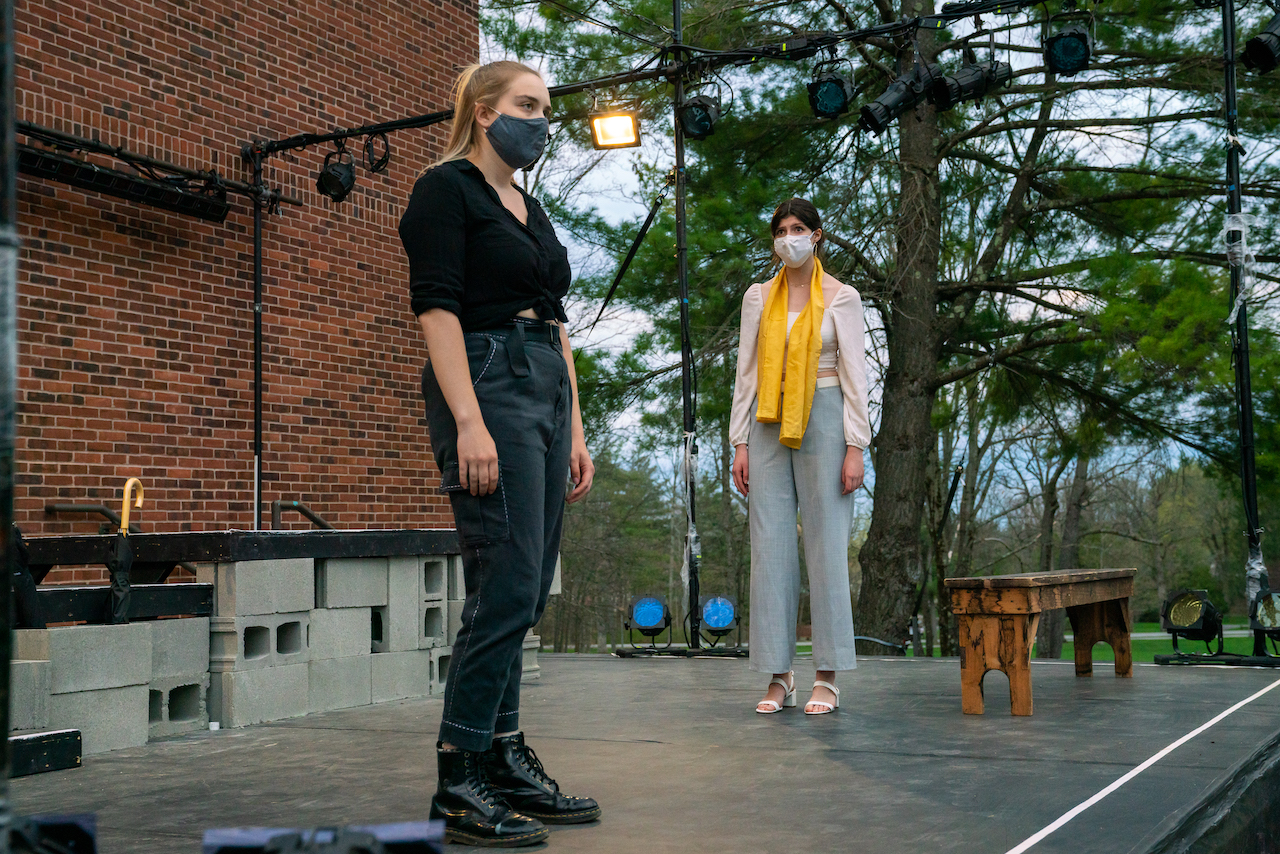
Photo by Wynn Lee ’21
Rostand’s Cyrano de Bergerac asks audience members whether we love people for their beauty or for what is inside their hearts. While Borrowed Letters asks the same of its audience members, the performance proposes said question in a different light. One of the most striking features of the show is that Cyrano, who is a male-identifying character, was portrayed as female by a female-identifying actress. The significant choice in casting changes the original narrative – that Cyrano’s fear is Roxanne rejecting him because he is ugly – to Cyrano’s fear of Roxanne rejecting her because she is a woman. Erin Arnold’s portrayal of the title character was so genuine that at the end of the play, the message is clear that the show is not about who is in love with who. The message behind Borrowed Letters is that no matter who you are, what you look like, or even what your gender is, if you have a good heart, you are deserving of love.
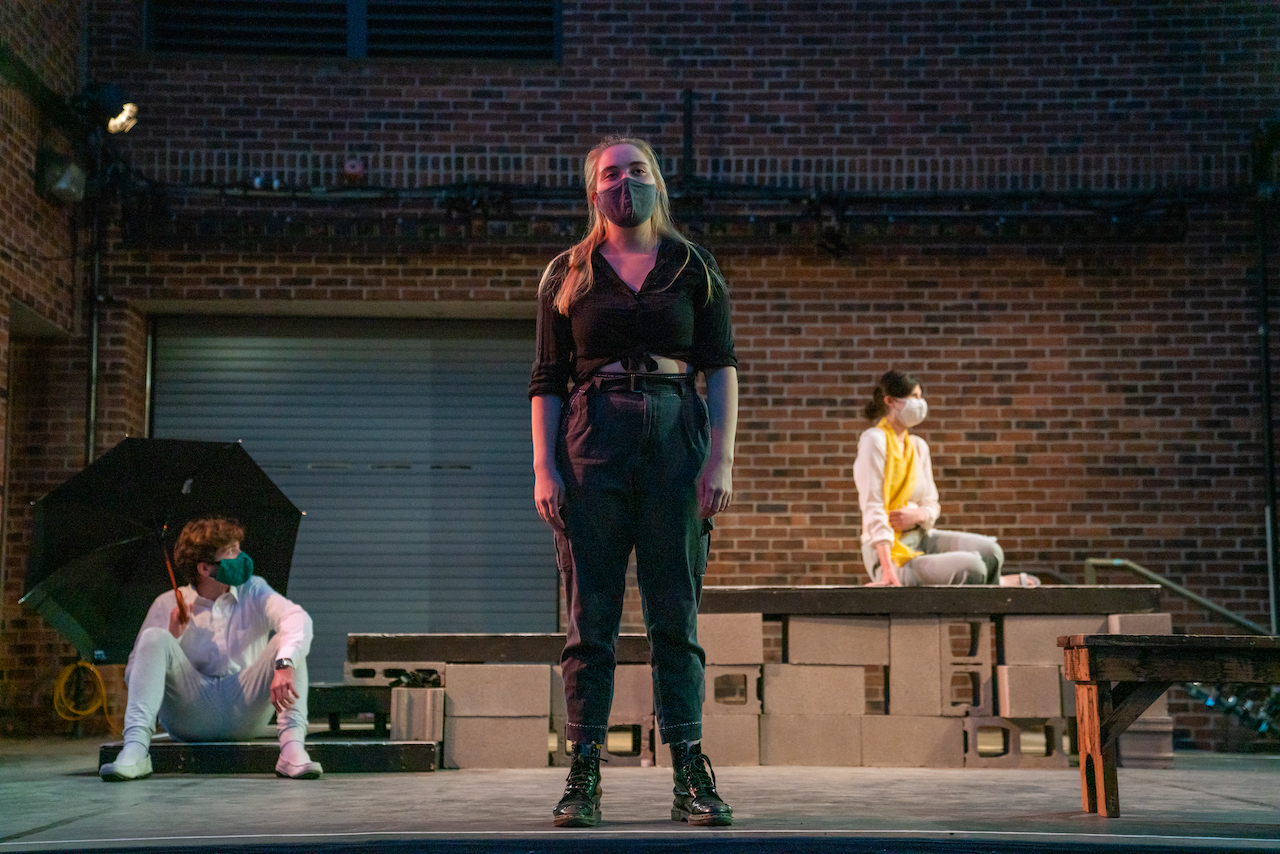
Photo by Wynn Lee ’21
If the use of a frame-story plotline and gender-bent roles weren’t enough, the costumes (designed by Olivia Ripley ’23) were a major clue that this classic French play would be getting a modern twist. Roxanne’s character arc goes from a naive, young aristocrat to a woman who strives to uncover the truth about love. Whereas traditionally Roxanne would be done up in a corset and dress, Gigi Brown took to the stage serving looks with gray pants, a white blouse, and a bright yellow scarf. This costume design showcases Roxanne as beautiful yet strong. The idea of strength is what fueled Gigi Brown’s portrayal of Roxanne, almost as if she was saying, “I am not one to be deceived.”
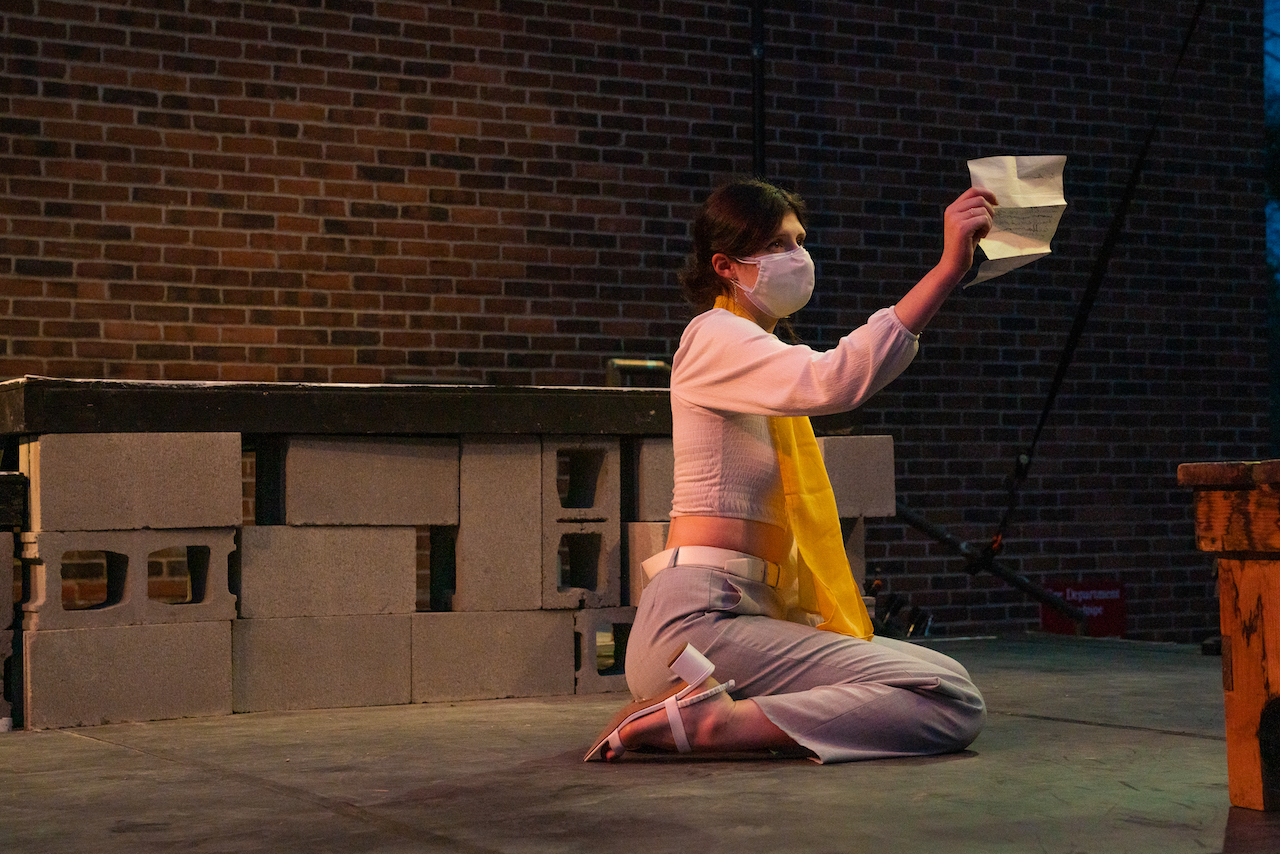
Photo by Wynn Lee ’21
The scenery of Borrowed Letters (designed by Kinzie Lane ’21) also tells the audience that this is not your average French play. Whereas Cyrano de Bergerac takes place in 1640 Paris, the loading dock staged was adorned with a cinder block terrace, a bench, and two umbrella holders to represent France’s capital.
A lot of the story is left up to the imagination of the audience, yet the actions of the characters brought the world to light. For example, when reading his letters to Roxanne, Jordan Gonzalez used an umbrella to disguise himself. Christian, as a whole, is a character that is really two characters; who Roxanne thinks he is, and who he really is. Later on, in the show, Erin Arnold would mimic Jordan Gonzalez’s original umbrella scene to show the audience it was Cyrano all along. In another two parallel scenes, we see Christian die with honor on the battlefield as Cyrano describes. The sound of a gunshot was mimicked by the banging of two pans; a trick put together by Props Master, Kinzie Lane ’21. However, the second time the audience sees this scene, the truth is revealed that Christian died after getting into an argument with Cyrano about who Roxanne truly loves.
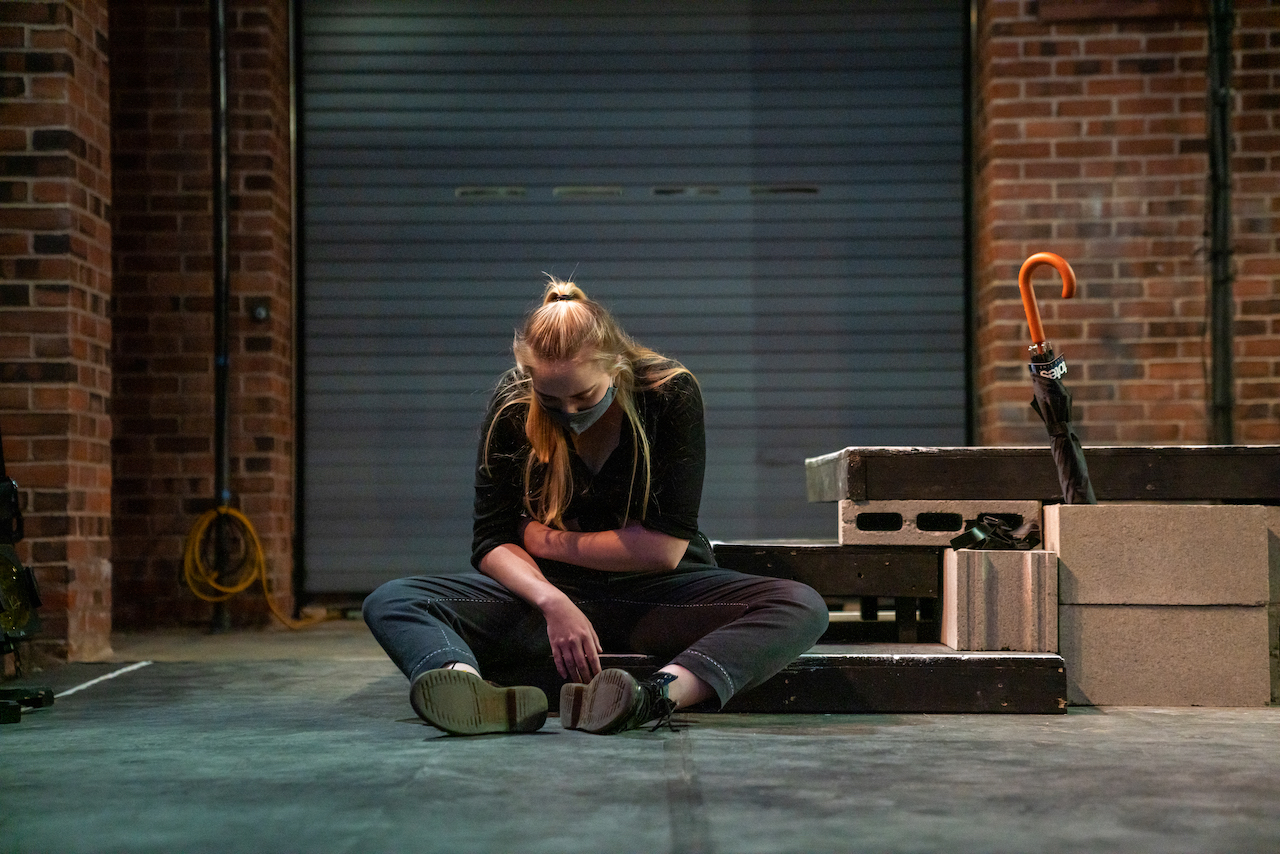
Photo by Wynn Lee ’21
Borrowed Letters, although based on a classic piece of drama, is not your traditional play. This modern, episodic piece tells Rostand’s tragic love story from the perspective of all the characters and not just Cyrano. This in fact makes the message of the play more impactful, as audience members get to see how love affects all parties involved. Love is not just a game or a star-crossed meeting at the balcony at night; it is a force that willingly possesses those who are good of heart. Cyrano and Christian may have deceived Roxanne, but all in the name of love. What Borrowed Letters tells us is that love is the greatest honor, that many would do anything for.
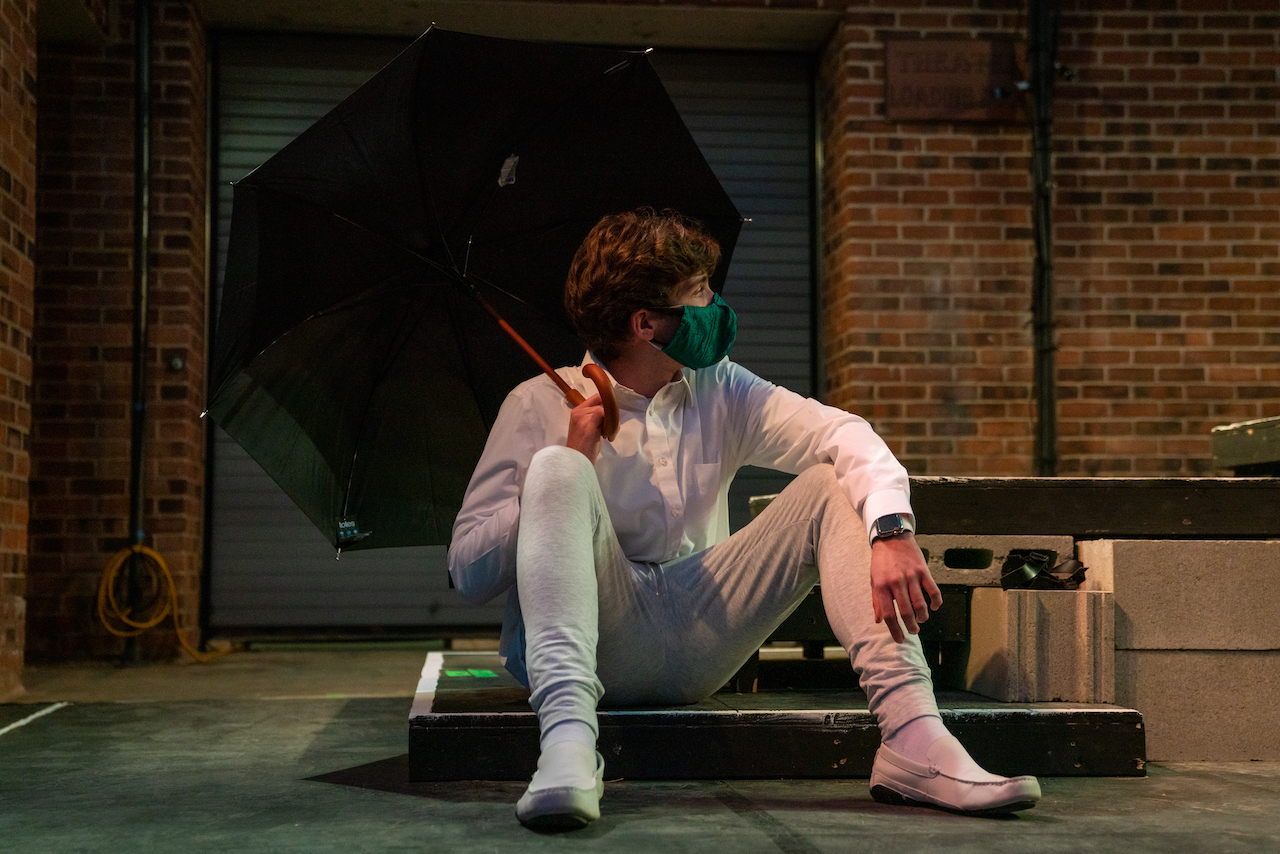
Photo by Wynn Lee ’21
LEAD ARTIST/DIRECTOR: Amelia Schuster ’21
STAGE MANAGER: Leah Cunningham ’23
SCENIC DESIGN/PROPS MASTER: Kinzie Lane ’21
COSTUME DESIGN: Olivia Ripley ’23
CAST: Erin Arnold ’23, Gigi Brown ’24, Jordan Gonzales ’24
___
Plano
Covered by Eliza Kuperschmid ‘21
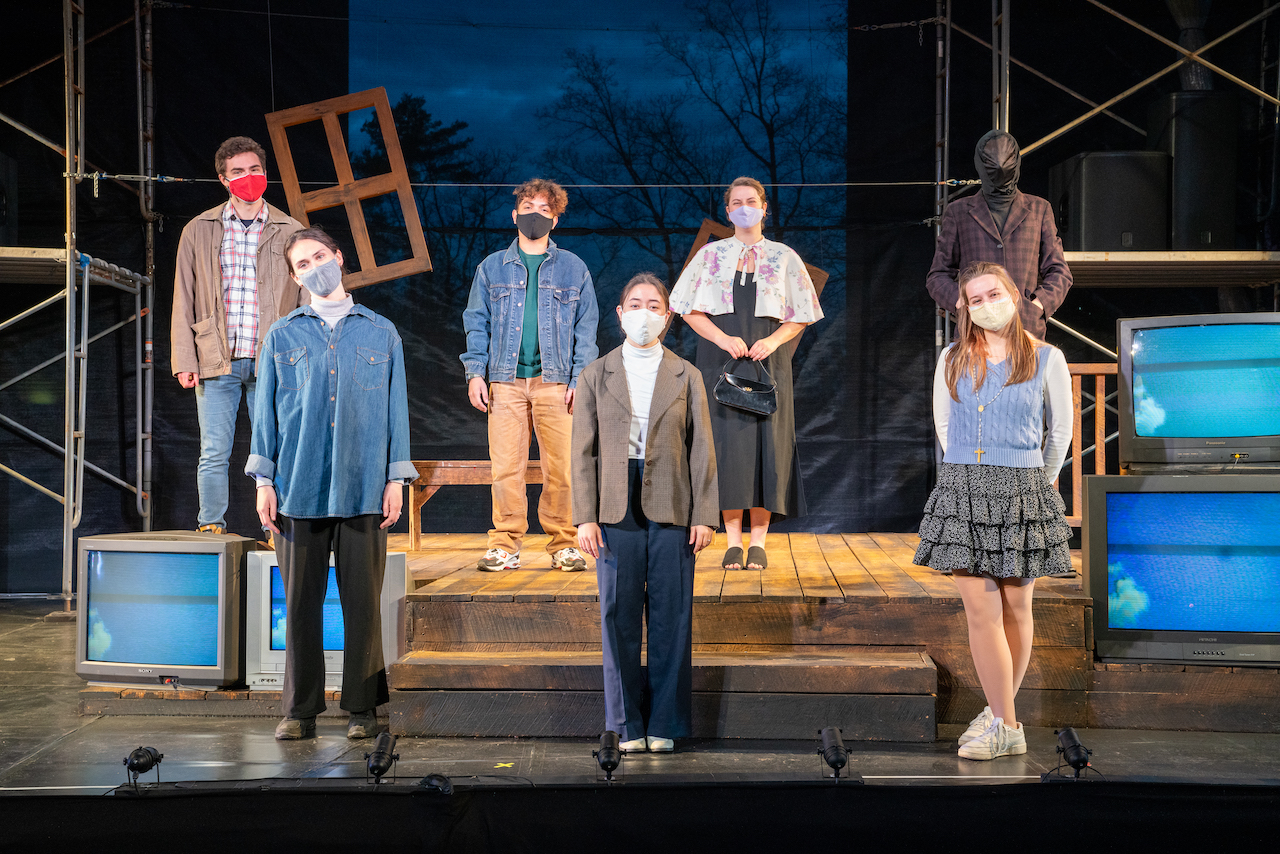
Photo by Wynn Lee ’21
As the audience settles into their seats at the Thomas Amphitheater to see Will Arbery’s Plano (directed by Hanna Yurfest ‘21), a figure, its face wrapped in black cloth, sits on the stage and casually flips through a book. We find out soon that this figure is a “Faceless Ghost” (played by Andres Priest-Lopez ‘21) and its presence on stage even before the house lights dim serves as a reminder that this play, and the characters in it, are haunted.
By haunted I do not mean like cursed or demonically possessed, I instead mean haunted by the ghosts of the past. By traumatic memories of childhood, by religion and fear. For the three sisters in this play, haunted by the men that have come and gone throughout their lives.
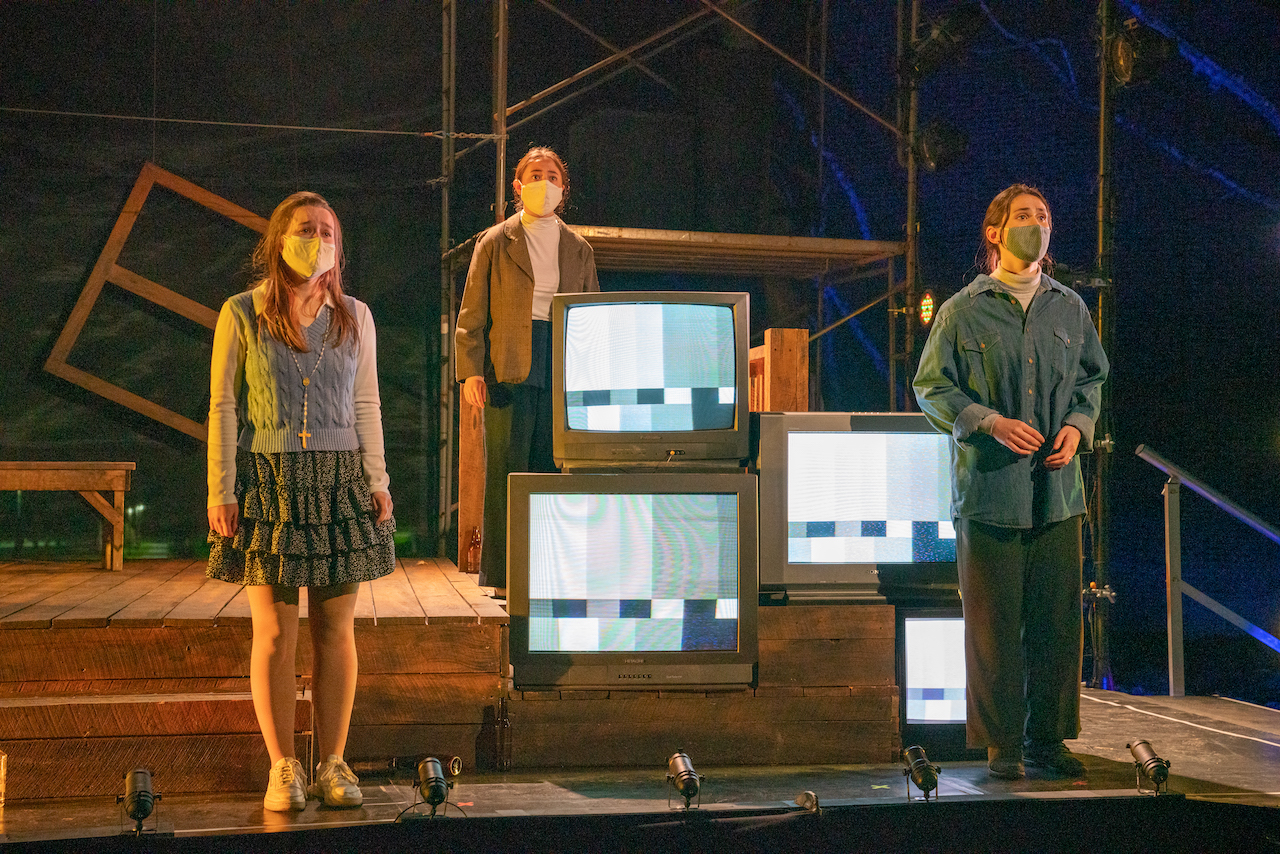
Photo by Wynn Lee ’21
The play begins with the three sisters — Anne (Juli Moriera ‘23), Geneveive (Izzy Maher ‘22), and Isabel (May Halm ‘23) — on a porch. Seems simple enough, right? Wrong. Nothing in Plano seems to follow natural laws of time or space. As the sisters rapidly catch each other up on new boyfriends, new pregnancies, and new revelations, they each take a turn announcing “it’s later” and the plot spontaneously jumps ahead in time. The play is also captivatingly self-aware; sometimes a sister will say “it’s later” while another sister insists that it is not, forcing everyone to remain in the present moment of the action.
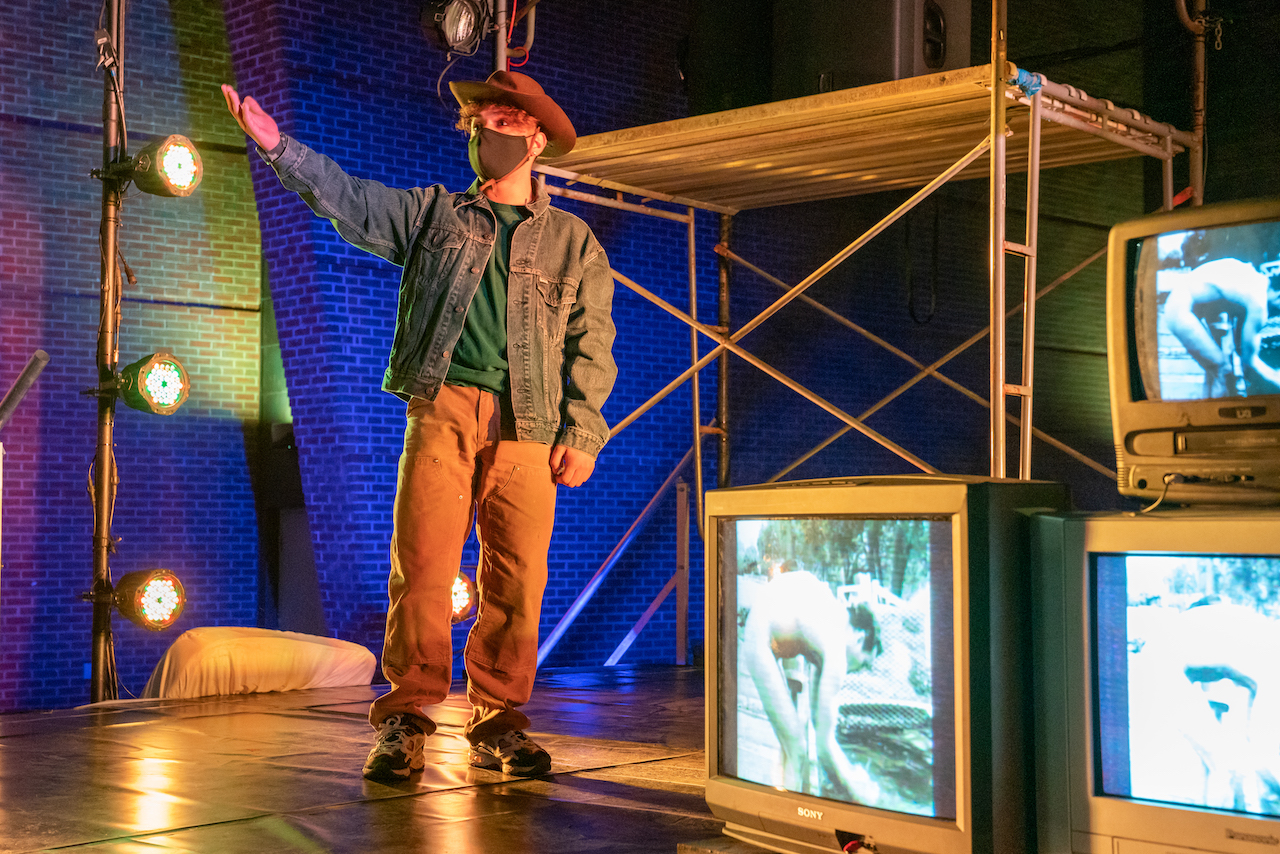
Photo by Wynn Lee ’21
As time progresses, relationships are revealed. Anne becomes pregnant by “John” (Fabian Rodriguez ’22), or is it “Juan,” as the sisters consistently (and cring-ely) stereotype the character. As Anne and John’s son “Javier Greg” grows, John becomes distant, often physically turned away from Anne and constantly leaving to go to “Plano.” Geneveive’s [soon-to-be-ex] husband Steve (Spencer Evett ’21) seems like a good guy that the sisters adore until he cheats on Geneveive and leaves the family. Steve’s character becomes strange, he somehow multiplies and inhabits two spaces at once (the porch and “Plano”). At one point, Steve even multiplies so many times that he invades each sister’s home, causing them to scream in fear at one another over the phone.
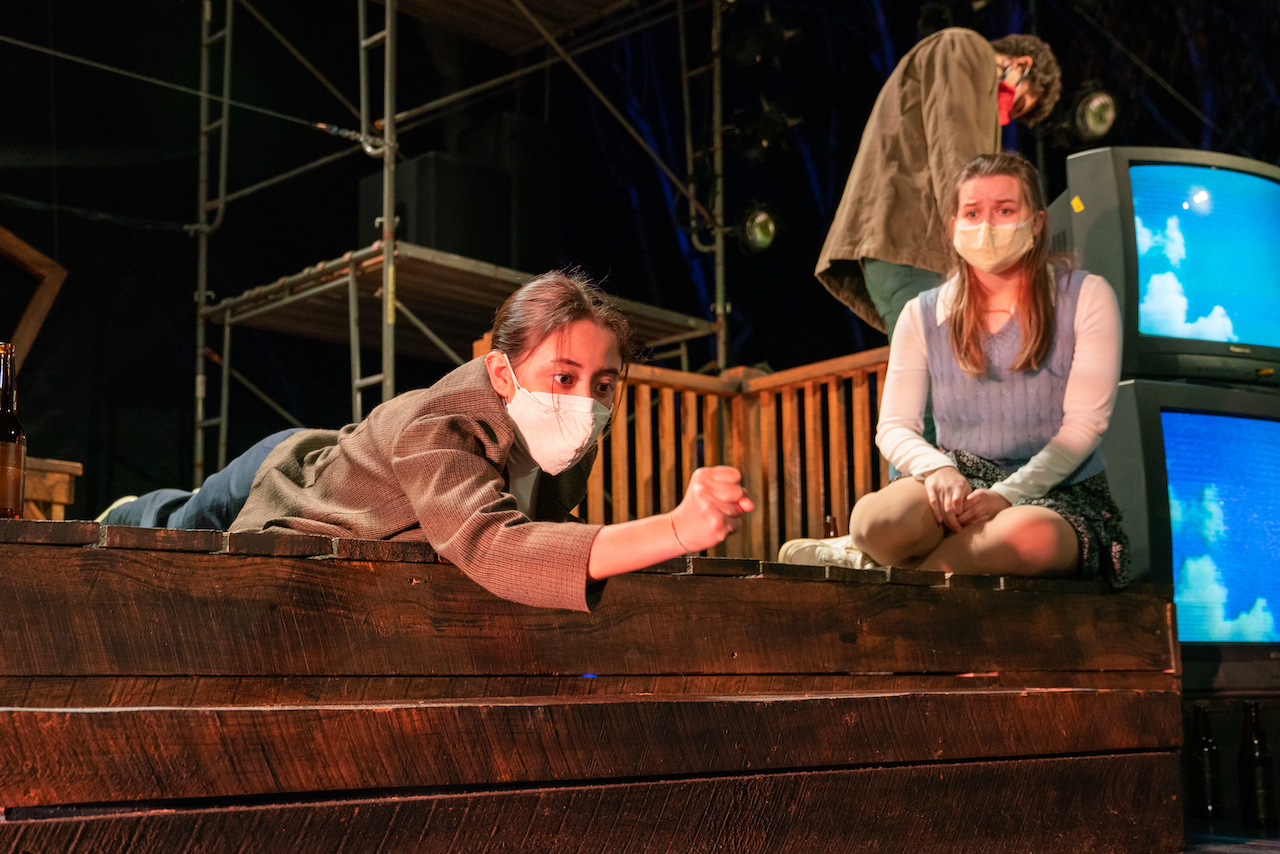
Photo by Wynn Lee ’21
As time marches forward with disregard for anyone’s happiness, we see each sister lose something. While Anne and Geneveive both lose their relationships, Isabel’s loss is much more palpable as it is the most transformative. Clinging desperately to her piety, goodness, and grace (sometimes literally clutching rosary beads), Isabel’s paranoia leads her to lose her innocence. When her rose-colored image of Steve is tainted by his infidelity, and with the Faceless Ghost hovering over her bed each night, Isabel’s sweetness leaves her body as she screams and cries.
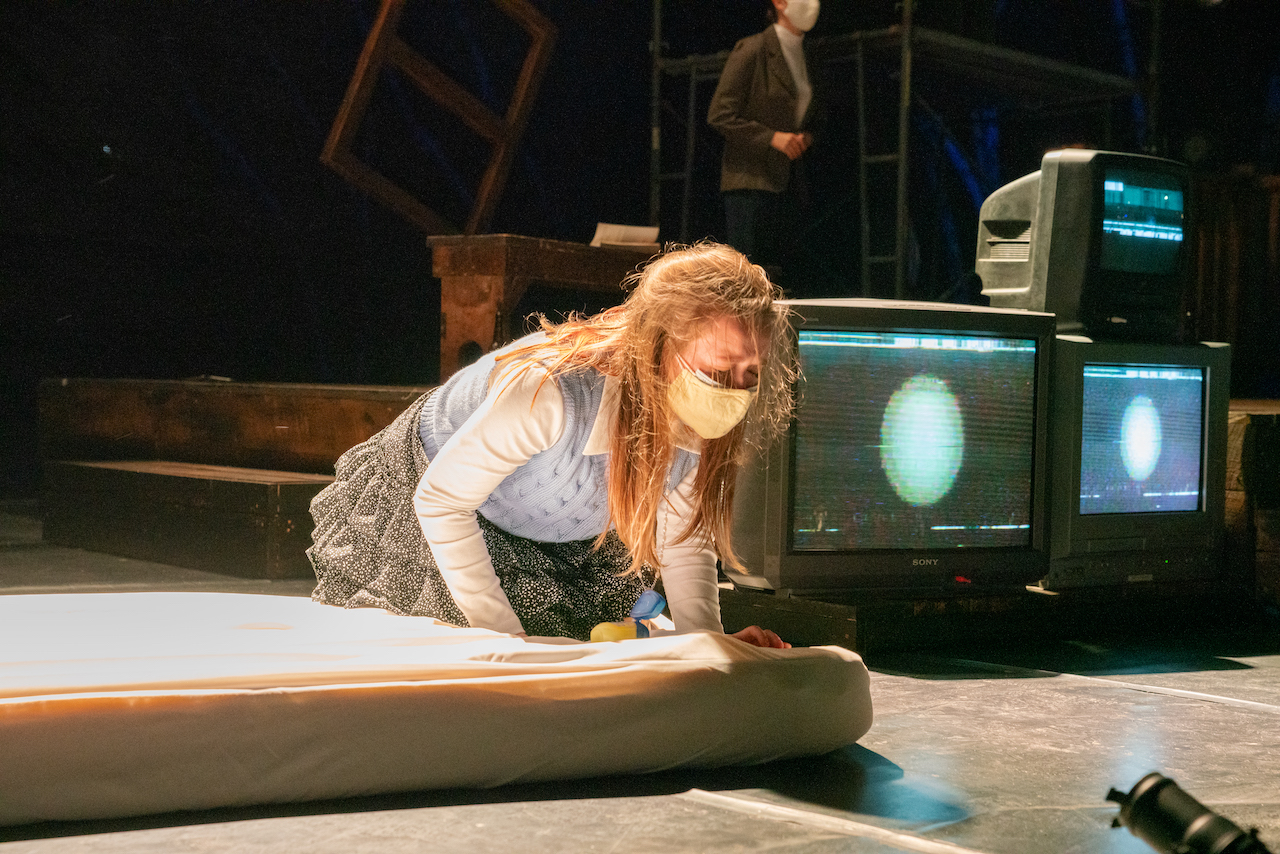
Photo by Wynn Lee ’21
The sisters have a final collective encounter with their past when they are transported to a realm with their deceased mother (Coco McNeil ’21). The mother interrupts each sentence with a violent “shush” and continues to remind the sisters that their father is around, another man that haunts the lives of these women. When prompted by Anne, the mother cannot seem to say one nice thing about any of the sisters, further solidifying their collective loss of innocence and goodness as well as the tragic reality of their childhoods.
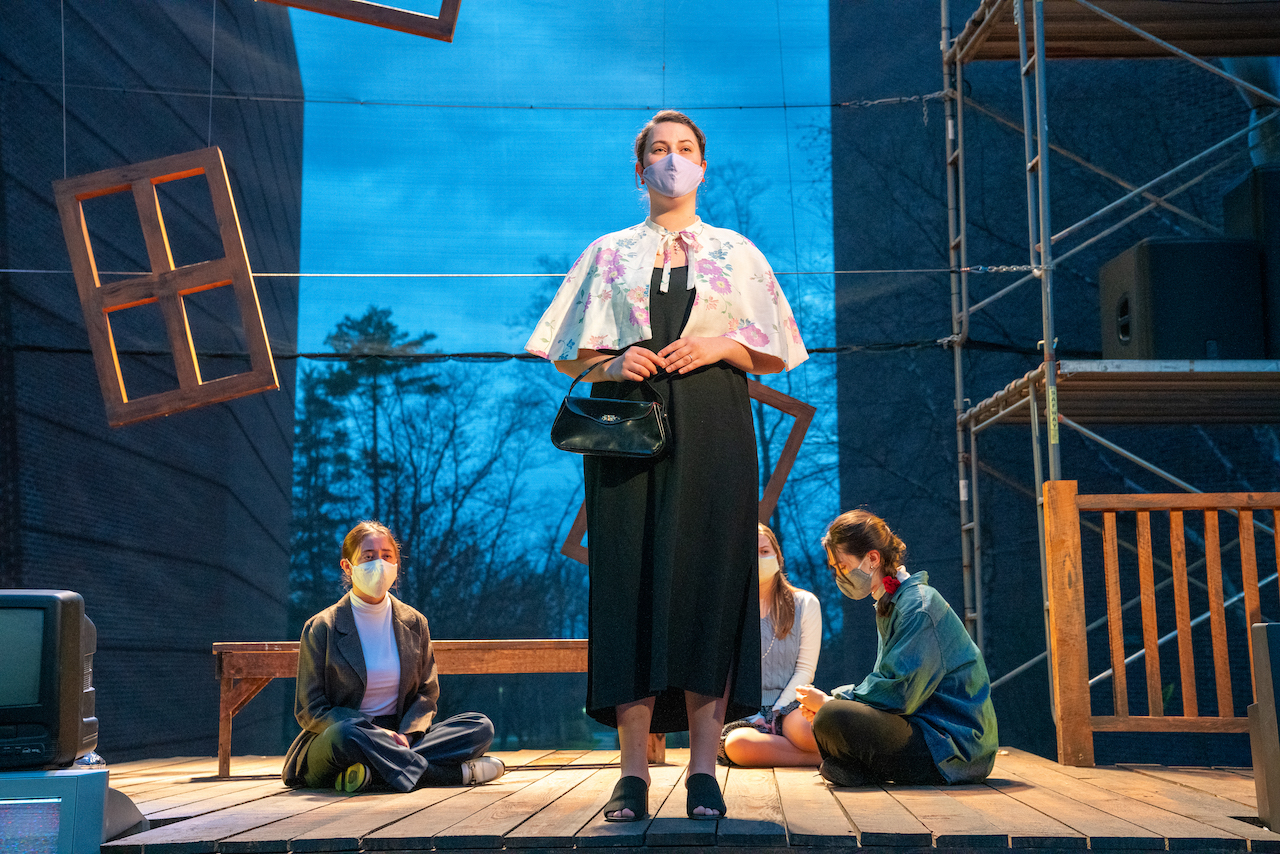
Photo by Wynn Lee ’21
To add an even more cryptic layer to the piece, “Plano” seems to switch its meaning each time it is used in the play. Sometimes, Plano is a noun, a place that John and Steve go. Sometimes Plano acts like an adjective, seeming to stand in for “strange” or “bad.” Sometimes, Plano is something entirely different, with Isabel saying lines like “I’ve undergone a Plano” or Steve saying “We’re in a play… no?”. These sort of “Easter Eggs” throughout the play made solving the puzzle of Plano all the more engaging as you never knew when or how information would be revealed next.
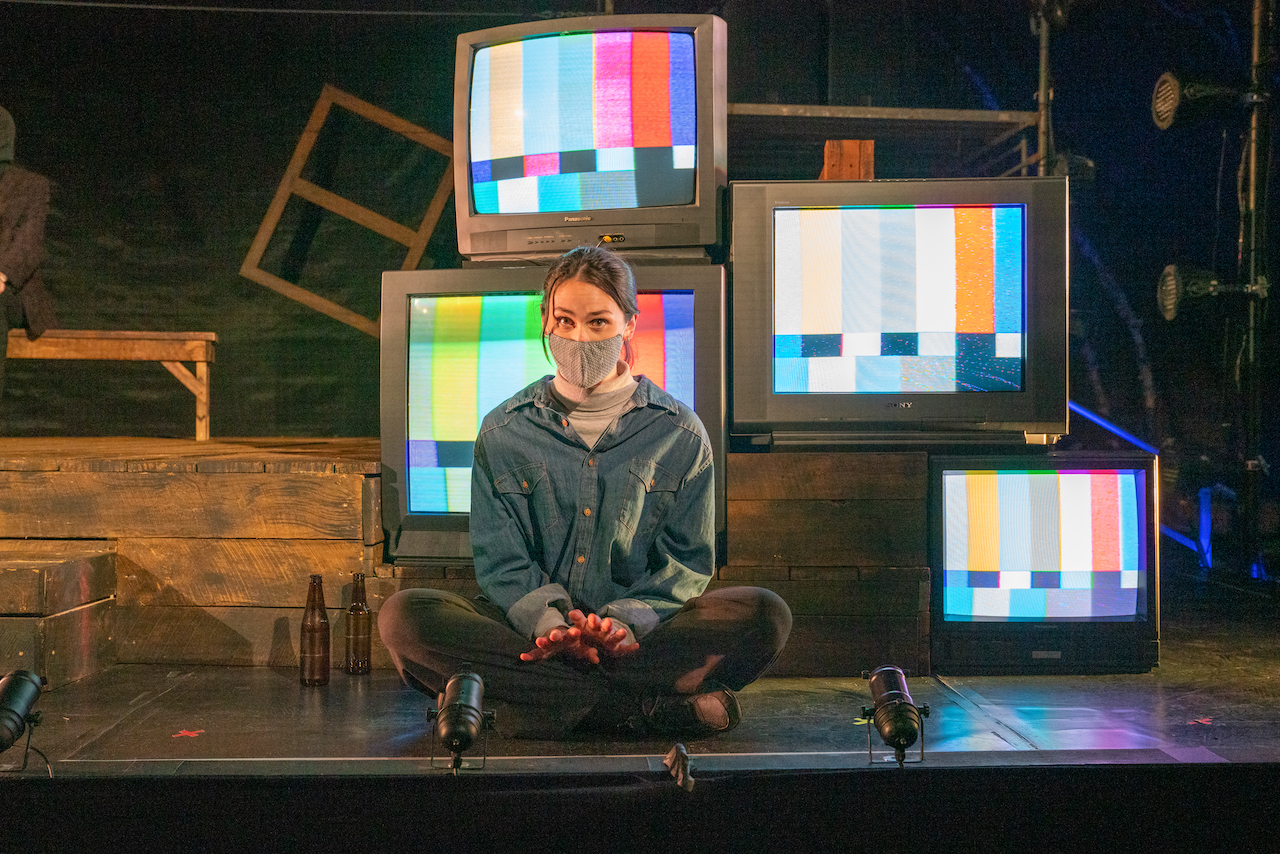
Photo by Wynn Lee ’21
Hanna Yurfest’s vision for the staging of Plano puts the haunting of the sisters by men at the forefront of the action. This is made clear by the use of early 2000s television sets, the most striking and noticeable element of the scenic design. Throughout the play, the televisions play slow-moving clips of clouds floating through the sky, the hiss and hum of classic-TV static ever present. Sometimes, the TVs would flip to compilations of old footage of men doing various activities like riding horses or acting in commercials. Sometimes, the TVs would be a more direct part of the action, literally flashing the word “BOYS” or even “MURDER” when the sisters violently chase and murder one of Steve’s multiplications.
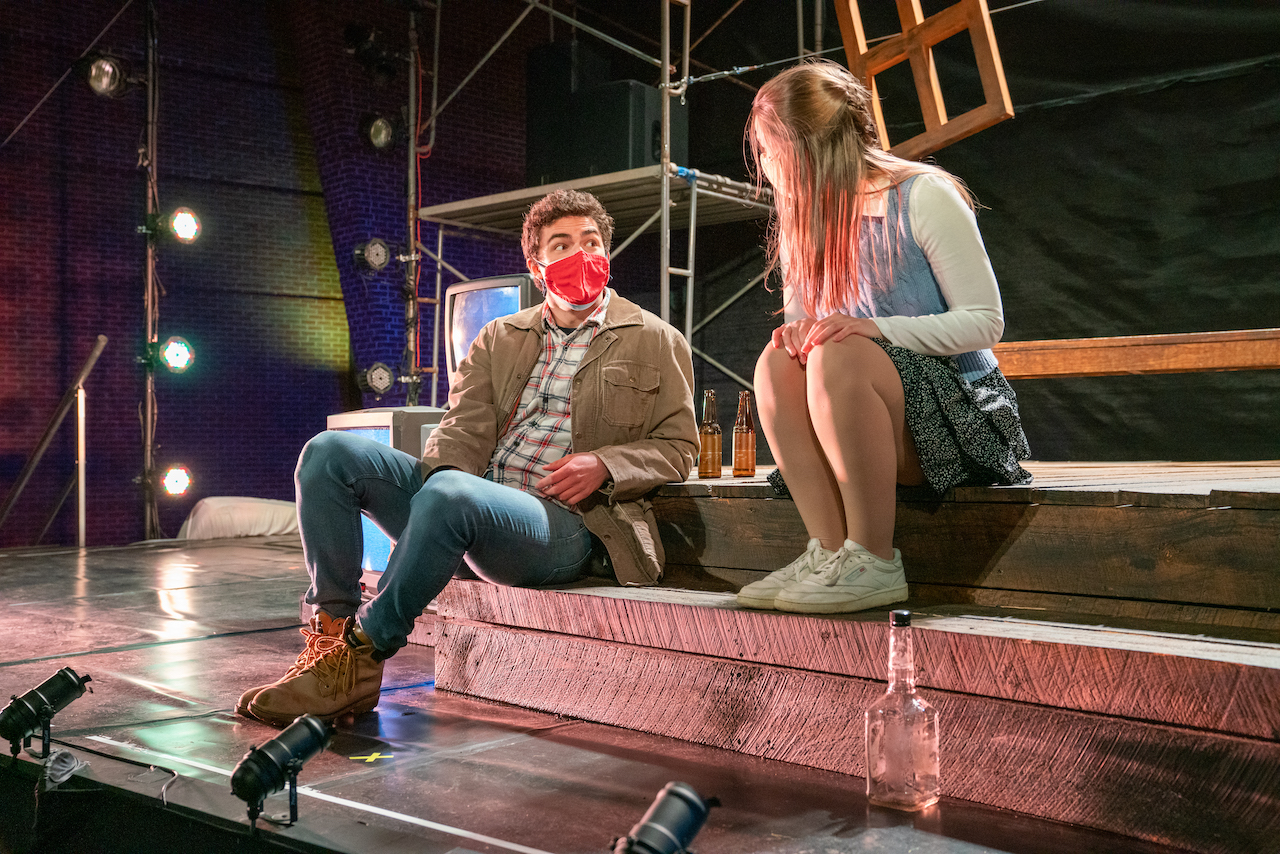
Photo by Wynn Lee ’21
The non-reality of the world of the play was made explicitly clear by the porch set, designed by Cianna Stovall ‘22. The windows of the “house” attached to the porch flew in disarray above the set. The mesh backdrop allowed the greenery of Skidmore’s campus to peek through, creating the disorienting illusion that we were somewhere that was both extremely familiar and extremely foreign.
Each person may have their own interpretation of what “Plano” or “A Plano” is, the play allows for much to be interpreted by individual readers and/or viewers. However, this staging made it clear that we must confront what haunts us, before it seeps into our lives like slugs.
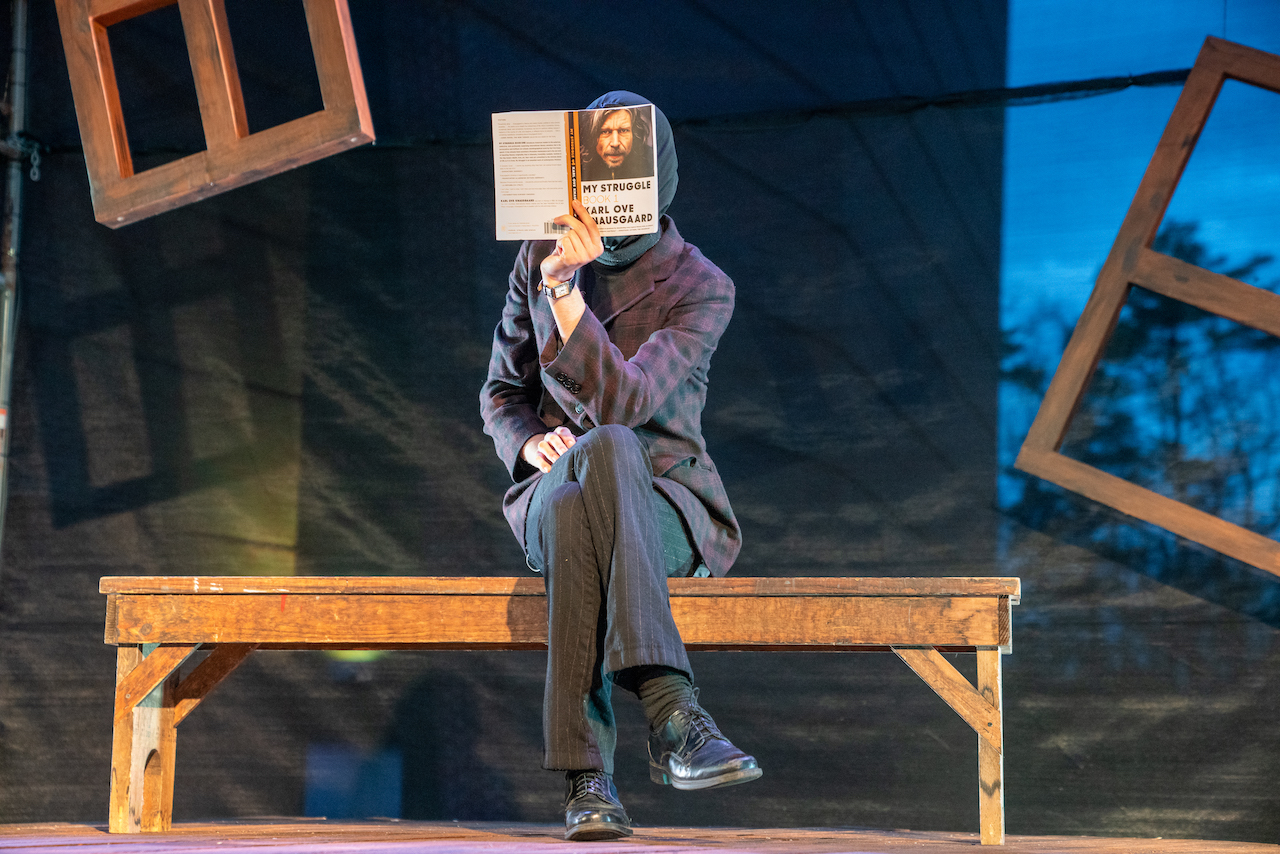
Photo by Wynn Lee ’21
LEAD ARTIST/DIRECTOR: Hanna Yurfest ‘21
STAGE MANAGER: Taylor Jaskula ‘21
ASST. STAGE MANAGER: Chloe Hanrahan ‘24
DRAMATURG: Coco McNeil ‘21
SCENIC DESIGN/PROPS MASTER: Cianna Stovall ‘22
LIGHTING DESIGN: Cas Clifford ‘21
SOUND DESIGN: Callan Daniel ‘23
COSTUME DESIGN: Camila Tardif ‘22
CAST: Spencer Evett ‘21, May Halm ‘23, Izzy Maher ‘22, Coco McNeil ‘21, Juli Moreira ‘23, Andres Priest-Lopez ‘21, Fabian Rodriguez ‘22
***
Eliza Kuperschmid ’21 and Gemma Siegler ’22 are Co-Editors-in-Chief of the Skidmore Theater Living Newsletter

